BACKCOUNTRY JOURNAL





Living in the hometown I grew up in, I’ve borne witness to the constant presence of development. The reimagining of outdated spaces, open fields now filled with condos or super stores, prairie replaced by concrete.
Change is inevitable. With it comes opportunities … but also challenges.
We all have places that call to us, places that seem just a bit more special than others. Last June I had the great fortune of spending almost 20 days on my home water during a work sabbatical. I was in a place my grandfather introduced me to when I was 10 and a place I have introduced to my children. I camped right on the water, pulling my raft out just next to camp then watching the light from the fire flicker on the metal raft frame … all blanketed above by uncountable stars helping me drift off to sleep. In the fall 2022 issue of Backcountry Journal, I wrote about my son Colin catching his first fish on a fly rod and then dining on brown trout in this very spot. To say that I’m head over heels for this exact place is an understatement.
This spring, I developed a deep hankering to reconnect to this landscape. I even had a dream that someone had bought some of the limited private property and built a gigantic lodge right on one of my favorite holes. It actually was less of a dream and more of a nightmare. I remember waking up as I was shouting.

As I drove up the bumpy dirt road anticipation was high. I approached my old campsite with butterflies dancing in my belly and heart.
As I neared the turnoff, I noticed what looked like some new construction. As I got closer, my eyes widened. Signs indicated that portions of the campsite were closed due to construction, yellow tape strung across one section. I parked the truck and went to investigate. What I found made my jaw drop. My favorite camp spot was no longer a camp spot. Instead, it was the official boat take out, buttressed by boulders.
My heart sank as I realized that I would never again camp here. I turned and headed to where the outhouse and a small grassy parking lot used to be and found trees cut down and grass replaced by an expansive, crushed gravel lot that could hold 20 rigs. Above the parking lot was a new road punched in with new campsites in the making. They didn’t quite pave paradise, but …
Before my father died, he and I did some selective thinning on our property just outside of town. We live in a ponderosa pinedominated forest, and we kept some fine specimens ... three of which I distinctly remember conversing about on a corner of what we call the old road. Since his passing I’ve made a habit of visiting these trees, knowing what a smile it would put on his face as they grew tall and strong.
A few years ago it was time to thin again, and my mom hired out to get that done. She flagged special trees, including those three ponderosas, that were not to be touched. The most robust was cut down without consultation so that the sawyer’s machine could make it around the corner. When I walked back up the old road and saw the tree down, I had the same feeling as when I realized my campsite was gone. Not only was one of my favorite trees gone; it also felt like a part of my father had departed.
With a couple years passing, however, the land has changed again. Oregon grape, glacier lilies and arnica flourish. I string deer heads between the two remaining trees; it’s a little weird but is something my mom and I both enjoy, since it allows us to watch nature do its work cleaning and bleaching the skulls.
Change. New opportunities and, with them, challenges like invasive weeds.
As I drove home from the river, I thought about the trees, and I thought about my hometown. Change is inevitable. With it comes opportunities and challenges. The scars will heal. More traffic in this particular spot will be inevitable, a definite foreseeable challenge. What was once paradise for me and my family will now bring opportunity for others – better river access and more campsites for a growing population. I take solace in the time I spent there last June – a gift that can never be taken from me.
Cherish what you have and stay vigilant. Change is inevitable. But we all deserve at least one slice of paradise forever.
Onward and upward,
Land Tawney President and CEO
Ted Koch (Idaho) Chairman
Ryan Callaghan (Montana) Vice Chair
Jeffrey Jones (Alabama) Treasurer
T. Edward Nickens (North Carolina) Secretary
Land Tawney, President and CEO
John Gale, Vice President of Policy and Government Relations
Frankie McBurney Olson, Vice President of Operations
Dr. Keenan Adams (Puerto Rico) Bill Hanlon (British Columbia) Jim Harrington (Michigan) Hilary Hutcheson (Montana)
Dr. Christopher L. Jenkins (Georgia)
Katie Morrison (Alberta)
J.R. Young (California)
Michael Beagle (Oregon) President Emeritus
Aaron Hebeisen, Chapter Coordinator (MN, WI, IA, IL, MO)
Chris Hennessey, Eastern Regional Manager
Jameson Hibbs, Chapter Coordinator (MI, IN, OH, KY, WV)
Katie McKalip, Vice President of External Affairs and Communications
Dre Arman, Idaho and Nevada Chapter Coordinator
Chris Borgatti, New York and New England Chapter Coordinator
Travis Bradford, Video Production and Graphic Design Coordinator
Tim Brass, Director of State Policy and Stewardship
Trey Curtiss, R3 Coordinator
Katie DeLorenzo, Western Regional Manager and Southwest Chapter Coordinator
Kevin Farron, Regional Policy Manager (MT, ND, SD)
Britney Fregerio, Director of Finance
Brady Fryberger, Office Manager and Executive Assistant to the President and CEO
Chris Hager, Washington and Oregon Chapter Coordinator
Andrew Hahne, Merchandise and Operations
On the Cover: Heading into the Pacific. Read “Wilderness of Water” on page 67.
Photo by Tyler Mann.
Above Image: Hunter Johnstone, 2022 Public Lands and Waters Photo Contest
Jeff Benda, Charlie Booher, Jamie Cameron, Mandy Carlstrom, M. Robbins Church, Patt Dorsey, Michael Engelhard, Kevin Fraley, Brian Halchak, Rebekah Hellesto, Greg Kvale, Tyler Mann, Mike McTee, Kris Millgate, Brittany Parker, Kurt Ratzlaff, Duane Radford, Wendi Rank, Kylie Schumacher, Reina Seraaj, E. Donnall Thomas Jr., Lori Thomas, A.R. Thompson, Grant Verhagen, Geneviève Joëlle Villamizar, Hayden Wennerdahl, Howard Whiteman, Cora Williams
Journal Submissions: williams@backcountryhunters.org
Advertising and Partnership Inquiries: mills@backcountryhunters.org
General Inquiries: admin@backcountryhunters.org
Trevor Hubbs, Armed Forces Initiative Coordinator
Gloria Goñi Mcateer, Digital Media Coordinator
Kate Mayfield, Operations Coordinator
Kaden McArthur, Goverment Relations Manager
Josh Mills, Conservation Partnership Coordinator
Devin O’Dea, California Chapter Coordinator
Brittany Parker, Habitat Stewardship Coordinator
Thomas Plank, Communications Coordinator
Kylie Schumacher, Collegiate Program Coordinator
Zack Williams, Backcountry Journal Editor
Interns: Sarah Garner, Peter Helman, Tanner Liermann, Jenna McCrorie, Sylvie Poore, Faith Wells
P.O. Box 9257, Missoula, MT 59807
www.backcountryhunters.org
admin@backcountryhunters.org

(406) 926-1908
Backcountry Journal is the quarterly membership publication of Backcountry Hunters & Anglers, a North American conservation nonprofit 501(c)(3) with chapters in 48 states and the District of Columbia, two Canadian provinces and one Canadian territory. Become part of the voice for our wild public lands, waters and wildlife. Join us at backcountryhunters.org
All rights reserved. Content may not be reproduced in any manner without the consent of the publisher.
Published June 2023. Volume XVIII, Issue III
JOIN THE CONVERSATION
Though much has been done to obscure this simple fact, how and what we eat determines to a great extent the use we make of the world – and what is to become of it.
-Michael Pollan







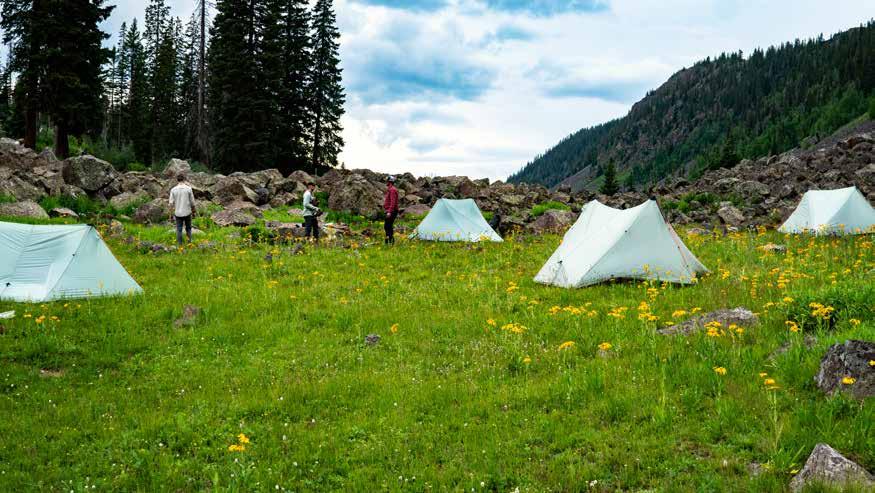



Some might guess the invention that tamed the West would be something complex and grandiose like the steam engine or the tractor. But, in reality, it is simple and unassuming. Barbed wire, invented in 1868, was an innovation that transformed the ranching industry, and it’s not a giant leap to argue it ultimately tamed the West. Before its introduction, grazing cattle required significant manpower to manage and wrangle strays. The advent of barbed wire provided an inexpensive method for ranchers to contain their cattle and better control grazing – making ranching more productive and efficient. But with that efficiency came great consequences for wildlife.
Wildlife, especially migratory big game animals, must negotiate major highways, urban areas, reservoirs, mountains, canyons and raging rivers to follow their historic migration corridors. The survivability of deer, elk, bighorn sheep, moose and pronghorn rely on connected landscapes and access to the habitat appropriate for the seasons. While the most insidious of barriers to movement may be roads and highways, fencing comes in at a close second as it can often separate mothers from their young and cause entanglements, which can lead to slow and painful deaths. According to a 2012 peer-reviewed study, there is an estimated annual mortality rate of one big game animal death per 2.5 miles of fencing, with juvenile mortality being eight times more likely than adults.
Fence ecologists estimate there is enough fencing in the American West to circle the equator 24 times. That’s 597,624 miles. In Colorado alone there are likely hundreds of miles of fencing on public lands that are no longer needed or functioning but continue to impact wildlife. When grazing permits expire or ranchers move on to other pastures their fencing remains, and land management agencies seldom have the capacity to remove it themselves. Our state and federal land and wildlife management agency partners see firsthand the impact of fencing on wildlife and are putting great emphasis on removal efforts. After an exceptionally rough winter in northwest Colorado, the need for removal has become even more

pressing. “I drove by six dead critters today hung up in fences in the Axial Basin area in just a very small, tiny corner of my world,” said Brian Holmes, a CPW biologist based out of northwest Colorado. “It’s really quite awful.”
Thanks to the National Fish and Wildlife Foundation and its funding opportunities for migration corridor restoration, land and wildlife management agencies do not need to tackle this issue alone. In the summer of 2022, with the support of NFWF, BHA set out to tackle this problem by hiring a habitat stewardship coordinator dedicated to fence removal in Colorado. Partnering with agencies like the Bureau of Land Management, Colorado Parks & Wildlife, the U.S. Forest Service and with the help of our dedicated volunteers, we intend to remove, map and modify 20 to 40 miles of fencing by the end of 2024.
There is an estimated annual mortality rate of one big game animal death per 2.5 miles of fencing.

Fencing is needed for a variety of reasons and will always be an essential tool in delineating property boundaries, protecting gardens, crops and containing livestock or pets. But fencing that is not built with wildlife in mind can, in fact, come at a cost to the rancher through the fence damage that occurs through wildlife collisions and entanglements. Ranchers can save money by constructing fencing that is friendlier to wildlife and allows clear access for wildlife in high-traffic areas.
Fencing that poses the greatest risk to wildlife is fencing that is too high to jump, too low to crawl under, has loose wires or wires spaced too closely together or is difficult to see. Woven wire, also referred to as sheep or mesh wire, can be the most lethal, especially for fawns and calves. Woven wire fencing acts as a complete barrier and is often flush with the ground, with one or two barbed wire strands on top, making jumping or crawling under nearly impossible and easily separating the young from their mothers. When separation occurs, they will likely die of starvation, be eaten by predators or be hit by a car.
With some simple modifications, fencing can become less of a hazard while still serving the purpose for which it was constructed. CPW recommends using smooth wire for the top and bottom strands; the height of the top wire should be no more than 42 inches with 12 inches between the top two wires and at least 16 inches between the ground and bottom strand. Next, the wire should be visible to avoid raptor and upland bird collisions. This can be achieved by simply flagging the top strand, using PVC or purchasing high visibility wire.
to digitally draw boundaries anywhere within the vicinity of the tower. When cattle approach the virtual boundary, they receive an audible warning; if they step into or over the boundary, they receive a shock. Not only does this technology remove the need for actual fencing, it also reduces the workforce needed and long-term costs for ranchers.
With the introduction of virtual fencing, fence removal will become even more needed than it is now. Many hunters have stumbled upon or tripped over downed fencing while out in the backcountry; others have even freed live entangled animals while out in the field. Which is why it is no wonder our volunteers have shown immense passion and dedication to this work, some driving up to eight hours to pull fence for an entire weekend. “I feel that fence-pulling is extremely important for wildlife.” expressed one BHA volunteer. “It is very satisfying – there is instant gratification in seeing the ‘before and after’ of our work. I have been to spectacular public lands that I never would have seen otherwise.”
When our members were asked in a 2022 survey what they would like to see BHA do more of, 71% said habitat stewardship was a top priority.
Since we started this work in July of 2022 we have removed and mapped 10 miles of derelict fencing in Colorado. While this is a feat we are very proud of, we still have a lot of work to do. In working with our agency partners, we are able to use their landscape-scale knowledge to identify and prioritize fencing based on overlap with high-priority habitat and the danger it poses to wildlife based on fence type. As backcountry hunters we are especially equipped to take on some of the more remote and labor-intensive jobs that require hiking in and carrying wire out of hard to reach, rugged terrain.
Many state wildlife agencies offer programs to make this transition more accessible for ranchers. Another option for livestock control is a new technology called virtual fencing. Using collars that communicate to GPS and reception towers ranchers are able
When our members were asked in a 2022 survey what they would like to see BHA do more of, 71% said habitat stewardship was a top priority. Our members are the voice and backbone of this organization, and we are proud to facilitate the work they believe to be the most important.

“I think it’s easy to agree that unnecessary fencing should be taken off the landscape.” said Nick Jaramillo, a BLM biologist with whom we have been working closely. “They are dangerous to sage grouse and raptors, big game, and other mammals, they complicate daily and seasonal movements, and more than once I’ve tripped on an unexpected loose strand of wire myself. BHA’s commitment to help is very much appreciated and will make life just a little safer for wildlife species facing enough challenges from humans and the environment.”
The good news is that there’s an army of loyal BHA members ready to roll up their sleeves and tear down some fence. Let’s get to work.


Brittany Parker is BHA’s Colorado habitat stewardship coordinator based out of Gypsum, Colorado. She is an avid hunter, angler, river paddler, river surfer and student of all things nature related.
Sharper than the day you bought them.

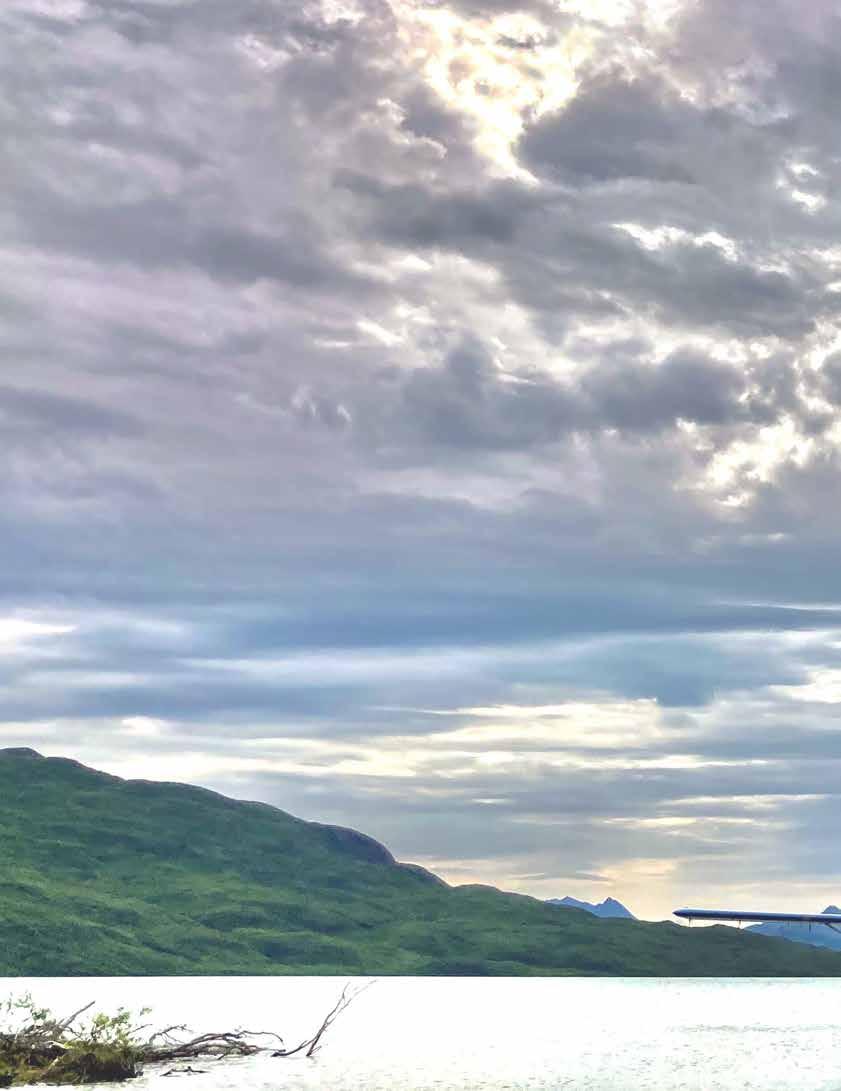
44 PUBLIC LAND OWNER
Why the Public Land Hunter and Angler Should Care About the Farm Bill by Charlie Booher
71 HUMOR
The Camper by Wendi Rank

Imaginary Lines by Mike McTee
78 SHORTS
Along the Tuckahoe by A.R. Thompson
A Conservation Trophy by Greg Kvale
83 BEYOND FAIR CHASE
Hamlet Goes Fishin’ by Patt Dorsey
85 FIELD TO TABLE
Walleye Reuben Sandwich by Jeff Benda
87 END OF THE LINE
In late May a federal judge ruled that four public land hunters from Missouri did not trespass when they “corner crossed” from one public parcel to another.
Back in 2021, after news broke of the attempt by a wealthy landowner to bring charges against these DIY public land elk hunters, BHA’s Wyoming chapter launched a legal defense fund whereby hundreds of BHA members and supporters contributed more than $142,000 to ensure these hunters received a fair chance in court. Through this campaign, along with pro bono legal work led by BHA volunteer Eric Hanson, we have stood up defend the legal rights of public land hunters and anglers everywhere.
Building on the “not guilty” decisions that have been issued by both a jury on criminal charges and a judge on civil charges, BHA is actively working to advance legislation in Wyoming and beyond that provide needed clarity that the public does in fact have a right to corner cross to access our public lands. For example, this past year in Wyoming, BHA led the passage of two important bills:
• SF 56 clarifies that a person must set foot on private ground to be convicted of criminal trespass.
• HB 147 makes it explicitly illegal to post public lands with “no trespassing” signs.
None of these victories would be possible without the leadership of Wyoming BHA chapter leaders – and ongoing support from BHA members and supporters like you! But our work on this issue is far from done, and you can help.
Follow the QR code to contribute to the legal fees in a potential appeal; sign BHA’s corner crossing pledge and get involved.

Your support as members of the BHA community and your commitment working for public access is how this victory happened. Thank you!
Valuable wildlife habitat and important cultural lands will be permanently conserved following the Biden administration’s designation of Avi Kwa Ame National Monument in southern Nevada and Castner Range National Monument in west Texas.

Avi Kwa Ame National Monument spans more than 500,000 acres of federal public lands that will continue to be managed by the Bureau of Land Management. The state of Nevada will retain wildlife management authority under the proclamation language, including active management for water resources to sustain wildlife populations. Hunting and existing public access opportunities will be maintained, and the proclamation requires representatives from the hunting community to be on the monument advisory committee.
Located on Fort Bliss in Texas, Castner Range National Monument comprises 6,672 acres of the historic testing and training site for the U.S. Army during World War II, the Korean War and the Vietnam War. The monument will be managed by the Army, and the landscape will undergo a Comprehensive Environmental Response, Compensation and Liability Act (CERCLA) process to ensure public safety. The region’s conservation will provide increased access to public lands that have been closed since 1966 in addition to connecting wildlife habitat, for species such as mule deer, with the adjacent Franklin Mountains State Park.
“Hunters in Nevada have long known the importance of the Avi Kwa Ame region to wildlife – none more so than our state animal, the desert bighorn – and to our outdoor traditions,” said Karen Boeger, a self-described “desert rat” who sits on the Nevada BHA chapter board.
“We thank the administration for recognizing the value of this landscape and especially for its direction to the Interior Department to continue its work with Nevada Department of Wildlife on a memorandum of understanding. We support the president’s taking action under the Antiquities Act to ensure that our kids and grandkids will be able to access these lands in perpetuity.”
BHA has consistently advocated for America’s national monuments system and the judicious use of the Antiquities Act as a way to permanently conserve important large landscapes. Key to achieving this outcome is a process that adheres to specific tenets and is locally driven, transparent, incorporates the science-based management of habitat, and upholds existing hunting and fishing opportunities.
The legalities of corner crossing, 40 years in the Forest Service, conservation in the 118th Congress and “Murder of the Kankakee Marsh” are just a couple of the recent topics on the Podcast & Blast.

Don’t miss all the latest from Hal Herring on BHA’s Podcast & Blast wherever you get your podcasts.
MeatEater Director of Conservation and longtime BHA North American Board Member Ryan Callaghan has been elevated to the role of vice chair for BHA’s North American board.
The ever-likeable and charismatic Callaghan continues to have a big impact on BHA’s work – whether through emceeing at Rendezvous, fundraising or speaking passionately on conservation issues. We look forward to seeing what he can do in his new role as vice chair!

Dre lives in Moscow, Idaho, with her sweetheart Paul and their German shorthair, OG. She enjoys befriending dogs, exploring public lands and expanding her comfort zone. As someone who was denied hunting opportunities as a youth, access to public land has played an integral role in her pursuit of a closer relationship with food sources and our natural systems.
The proactive approach that BHA takes to conserving our public lands, waters and wildlife in alignment with the North American Model of Wildlife Conservation is something she feels passionate about, and she is thrilled to help move BHA’s mission forward through her role as the ID/NV coordinator driving important program work in Idaho’s High Divide region and elevating priorities with BHA’s chapters in both Idaho and Nevada.
At the 12th annual North American Rendezvous, Backcountry Hunters & Anglers announced its 2023 award winners. BHA’s highest honors recognize individuals, chapters and entities that set themselves apart with their demonstrated commitment and unending effort on behalf of public lands and waters, fish and wildlife, and hunting and fishing.
The 2023 awardees are as follow:
Tony Wasley, former director of the Nevada Department of Wildlife and current president of the Wildlife Management Institute, received BHA’s Aldo Leopold Award for exceptional work and dedication to the conservation of terrestrial wildlife habitat.
Don Holmstrom, a BHA life member from Boulder, Colorado, was presented with BHA’s Sigurd F. Olson Award, which recognizes outstanding effort conserving rivers, lakes or wetland habitat.
Corey Ellis, a BHA member who lives in Missoula, Montana, is the recipient of the 2023 Jim Posewitz Award acknowledging outstanding ethical behavior in the field and the education of the outdoor public on the importance of ethical behavior.

Harrison Stasik, former president of the University of Wisconsin-Stevens Point BHA college club, received BHA’s Rachel Carson Award, which honors young leaders for outstanding work on behalf of hunting, angling and conservation.
Justin Spruiell, from Yelm, Washington, was presented with the Dwight D. Eisenhower Award for positive impact on BHA’s Armed Forces Initiative and the military community.
G&H Decoys is the recipient of BHA’s Larry Fischer Award, which honors the memory and contributions of a longtime BHA board member by recognizing exceptional dedication by a business to BHA’s mission.
Andrew McKean, the Glasgow, Montana-based journalist who currently is Outdoor Life’s hunting and conservation editor, received BHA’s 2023 Ted Trueblood Award for outstanding communications on behalf of backcountry habitat and values.
BHA’s Texas Chapter was presented with the George Bird Grinnell Award, which honors the outstanding BHA chapter of the year.
Finally, Buzz Hettick of Laramie, Wyoming, received the Mike Beagle-Chairman’s Award. Named after a BHA founder, it is given to an individual who shows outstanding effort on behalf of BHA.






This is our workhorse, the ideal do-it-all option for most hunters. With each design decision, we sought the perfect balance: a shell that provides rugged protection without sacrificing flexibility; a true stealth fleece that’s still lightweight and breathable; all the technical details you want without the extras you don’t. Available as a jacket, vest, hoodie, and pants.






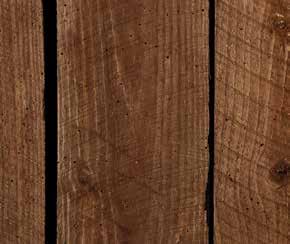



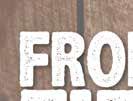





















RIDGECREST, CALIFORNIA California Chapter
I first stumbled upon BHA on Facebook. As a new hunter, I was seeking opportunities to learn and connect with others. Someone had shared a conservation event, which included camping, in Kernville. It was family-friendly and right up my alley but, unfortunately, I was unable to attend.

But it did inspire me to look into the group. I saw BHA’s involvement in advocating for critical issues affecting wildlife and public lands, the desire to educate people, and the amazing experiences the organization has to offer. After attending a few events, I knew I had found my people – a group of individuals who share my values and could help me learn and grow, not only within the hunting community, but as an individual.
YOU REGULARLY VOLUNTEER AT CALIFORNIA CHAPTER PROJECTS. WHAT INSPIRES YOU TO DEDICATE YOUR TIME TO HELPING OUT? AND WHAT DO YOU FIND REWARDING ABOUT THE PROCESS?
Volunteering has always been something I have enjoyed. It enables me to invest in my community, support causes in which I believe and establish relationships. I especially want to volunteer when it comes to supporting an organization like BHA, where the leaders work hard to organize events that provide me opportunities to participate in adventures, continue to learn and develop skills and connect with like-minded individuals – and I have to say, I have met some really great people. By volunteering and helping where I can, it is my way to give back and show my appreciation for all they do.

The Kern River Cleanup was my first BHA event. It was a small gathering. I was actually one of two who found money while picking up trash alongside the road and the surrounding areas! Though, I think it was the other guy who found $20. I had found a $5 bill. When I found it, I was stretched over some side railing, trying to get a bunch of trash lodged deep into a bush. One of those pieces of trash happened to be money!
INITIATIVE? WHAT IS IT ABOUT THE AFI THAT RESONATES WITH VETERANS LIKE YOURSELF?
As a military vet I have attended two BHA AFI program events — the Anza helicopter guzzler haul and the AFI Vandenberg poke pole fishing. What I appreciate about the AFI program is that it provides those who served or are serving with a sense of community and purpose. This can be especially helpful to veterans that struggle with adjusting to their civilian life. It is a place to build camaraderie outside of the military. Organized events allow veterans to meet up with others who may have shared similar experiences and tribulations. It is an opportunity to share stories and laugh about things those who have never served may not understand. Also, participation in outdoor activities allows individuals to connect with nature, which can be a safe outlet for whatever trials one may be experiencing.
As uncomplicated as a perfect day would be for me, it is not easy to describe: Location and activity have little to do with it but more so how the awe and wonder of a place can cause me to swell with gratitude for the life I am fortunate enough to be able to live. Having the ability to escape to public land often enables me to have those moments.





Hunter: Melissa Early, BHA member |
Species: dusky grouse
State: Utah
Method: shotgun
Distance from nearest road: one mile
Transportation: foot
Hunter: Clint Hukill, BHA member


Species: mule deer | State: Colorado | Method: bow

Distance from nearest road: four miles
Transportation: horseback, foot
Hunter: Scott, BHA member
Species: American alligator

State: Florida|
Method: snatch hook
Distance from nearest road: one mile
Transportation: kayak
Hunter: Jon Dykes, BHA member
Species: black bear State: Washington
Method: rifle
Distance from nearest road: 11 miles
Transportation: foot, mountain bike
Hunter: Jessie Janowski and Olive the GSP
Species: ptarmigan | State: Alaska | Method: shotgun


Distance from nearest road: five miles | Transportation: foot
Hunter: Collin Mann
Species: Shiras moose
State: Colorado
Method: bow | Distance from nearest road: four miles
Transportation: foot






• A deciduous tree’s leaf on the ground.
• A conifer’s needle on the ground.
• An animal’s paw- or hoof-print and identify it
• A duck
• A songbird
• A purple flower
• Walking stick
• A grasshopper
• A plant seed
• An animal’s nest or bed
• Something that is decomposing
• Moss or lichen
• Mammal poop
• Name three different sounds you hear while in nature ? (Not made by people or machines.)
• The closest public water to your home.
• The closest hiking trail to your home.
• The closest wilderness area to your home.
• The closest spot to go camping to your home.
• A snack while sitting on a log or rock
Cora Williams is the 3-year-old daughter of Backcountry Journal Editor Zack Williams. She likes sleeping in tents, morel hunting, gobbling at turkeys, looking for deer and wildflowers and, especially, farm animals.


Hearing BHA President and CEO Land Tawney talk about our 640 million acres of public lands is inspiring, right? And it feels great to think of being an American citizen and sharing ownership of all those vast and beautiful places. But what if those places were so far away from you that it was impractical to get to them?
There are a lot of public areas in America, but unfortunately they are not spread out evenly across our great country. Many agricultural states in the central U.S. have very little public land. When ranking American states by percentage of public lands, you will find Kansas (2%), Nebraska and Iowa right near the bottom. Not only are those states and others lacking large areas of public lands, but very little new public land is ever added to the total. Why is that?
Well, in Kansas, a law states that when a landowner wants to sell land of 160 acres or more to the state of Kansas, the sale must be authorized by the Kansas Legislature. Yes, the Legislature must approve a sale between a willing landowner and the state! Think about that for a minute: In the situation where a farmer or rancher wants to sell land to his own state, he is unable to do so until the entire Kansas State Legislature says he can. In other words, in America, a sale that hardworking citizens want to make cannot be completed until the state’s government approves it? The farmer’s own land, land with his blood and sweat in it, can’t be sold to whomever he pleases – but only if that happens to be his own state? We are not talking about selling to China or Russia. We are talking about his own state – an idea that seems wholly and completely un-American!
farmer and is holding it so that if a bill authorizing the purchase by the state ever gets passed, PF will then sell the land to the state. So, a little 264-acre patch of land, right smack-dab up against an existing wildlife area, could not be sold directly to a farmer’s own state government!
The Kansas chapter of BHA has regularly addressed this issue on its podcast and in its monthly newsletters, but these actions alone have not been enough to move the needle. This year’s bill for the proposed sale of the 264 acres never even was heard in committee. That is how powerful the groups are that use this “poker chip” in the games they play. The politicians and lobbyists used the same baseless arguments they’ve used for years and killed this bill before there was even a fight.
In response, the Kansas chapter created a YouTube video to discuss all the bogus arguments used to defeat the bills for the purchase of additional lands in this and similar situations – explaining and debunking the myths. The arguments, as the video points out, do not hold water. Hopefully, the video can be utilized in the future to explain to anyone involved that there is nothing to fear, and the sale should be authorized.
But realistically, wouldn’t it be better to completely do away with this asinine law? Why would we be concerned if a landowner wants to sell his or her land to his or her own state? That same farmer or rancher can sell that land to a real estate developer or a multitude of other entities without any interference from the state government. To restrict a landowner’s right to sell land is absolutely the taking of a right of ownership and cannot be done without just compensation.
The Kansas chapter continues to educate our members and the greater public about this situation through the Kansas BHA Podcast, the chapter’s monthly newsletter, the video on YouTube and education at every possible event. The education process includes farmers and ranchers, too. In many cases, landowners have been fed a full diet of misinformation or incomplete information regarding the facts.
Think about that for a minute: In the situation where a farmer or rancher wants to sell land to his own state, he is unable to do so until the entire Kansas State Legislature says he can.
To make matters worse, there are certain politicians in Kansas who use this situation like a poker chip for their own gain. They are playing games with other people’s farms, ranches and the lifetime of sweat that has gone into those farms and ranches. And perhaps the most offending part of that game is that the politicians who most often do that masquerade as hunters!
In reality, they are actually businessmen looking to turn an even greater profit. They are people who own large private hunting clubs and do not want any public hunting in the state. And they are huge, membership-driven lobbying groups that use this situation to sell memberships by misinforming farmers and ranchers about the facts surrounding these proposed sales.
This year’s version of this ongoing story in Kansas revolves around a 264-acre parcel of land adjacent to the Lovewell Reservoir Wildlife Area. A farmer wanted to sell his farm to the state so it would become a part of wildlife area, but he could not because it takes too long to get a bill through the entire Kansas legislative process.
Luckily, in this case, Pheasants Forever bought the land from the
Some may point out that Kansas did manage to acquire title to a tract of about 500 acres just a few years ago. But the authorization for the state’s purchase of that land occurred several years after another conservation group similarly stepped up to purchase the land. Thanks, Ducks Unlimited! Of course, those DU funds could have been utilized for habitat development or some other beneficial purpose instead of being tied up in this parcel for several years. And the same goes for PF’s funds tied up in the proposed Lovewell SWA property.
Please join Kansas BHA’s efforts and let the Kansas Legislature know that you believe this law should be eliminated. Watch the YouTube video and then sign the petition. Grassroots efforts such as this are one of the best ways concerned citizens can break through the existing power structures set up by very influential lobbying groups and misguided legislators.
BHA’s Kansas Chapter Chair Kurt Ratzlaff is a happily retired attorney who spends as much time as possible pursuing upland birds, big game and tall tales from backpacking trips. Those pursuits are occasionally interrupted by the Boundary Waters and regularly by cheap bourbon.
BHA’s Kansas chapter battles for more public land in a state with some of the least
June on Alaska’s famous Kenai River: Once anglers used to flock for the chance to catch a Chinook (king) salmon of a lifetime. Today, the fishermen you encounter are more likely to be in pursuit of their daily limit of sockeye (red) salmon. Kings still swim by in the blue, glacial waters, en route to their spawning grounds, but they are fewer and smaller in size than ever before.
July, several hundred miles north to the banks of the mighty Yukon River: Alaska Native fish camps and sled dog yards that just a few years ago bustled with activity, noise and happiness instead are empty and silent. Fish racks that were once laden with beautiful, oily, orange king filets, representing a winter’s supply of food for village residents, now sit hollow along the hissing, silty behemoth of the river.
Unfortunately, these scenes are increasingly common across much of Alaska. King salmon runs, which were formerly considered so abundant that the thought of scarcity was laughable, are struggling in the U.S.’s largest and wildest state.
The reasons for recent salmon population declines are unclear and undoubtedly numerous. Overharvest in the ocean and along the rivers that kings ascend to spawn, commercial trawling bycatch, disease, predation at sea, less-productive ocean waters and warmer spawning streams are identified as likely culprits. As for the declining size of king salmon, past selective harvest of the largest individuals and bioenergetic limitations caused by a warming ocean are the leading theories. Fingers are pointed, and blame is volleyed back and forth between increasingly entrenched stakeholder groups.
From BHA’s viewpoint, representing anglers who enjoy catching and harvesting these king salmon, which constitute high-quality food and sport, the blame game is not productive, and one thing is crystal clear: There is a problem with many king salmon runs in Alaska, and all stakeholders can and should contribute to a solution in any way they are able.
Scientists focus on studies that will identify and propose solutions to ecological problems that may be impacting kings. Commercial and charter salmon fishermen can prioritize the resource over shortterm profit by taking steps to limit their harvest. Groundfish trawlers can scale back harvest to minimize salmon bycatch. Management
officials can incorporate sound science and implement progressive regulations rather than caving to political pressures. Subsistence fishers can and do utilize their platform as Alaska’s first stewards and stakeholders of salmon populations to positively influence management. And recreational anglers, such as BHA members, can and do bear additional restrictions, lower bag limits and often fishery closures for their part in conserving salmon runs.
A great example of an angler and business owner working to contribute to a solution is Matthew Crowe, BHA member and owner of Alaska Rod Company. Alarmed by the decline of Kenai Chinook, he created a line of “Conserve Kings” apparel from which 100% of profit goes toward conservation nonprofits that help promote king salmon conservation.
Matthew knew he had to do something. “I went back to school and got my degree in fisheries and began working on the Chinook sonar program on the Kenai. Soon after, I founded Alaska Rod Company and felt I should use my company to help in any way possible. Developing a conservation apparel line was an area I felt could help contribute,” he says. “My goal is to spread awareness of the issue and help unify all user groups to look inward and see how we all can contribute.”
Inspired by proactive BHA members like Matthew, the Alaska BHA chapter plans to wade in on this issue for the betterment of Chinook salmon populations and angler opportunities. The first and most obvious step toward this will be to raise awareness to state and national audiences through pint nights, river cleanups, blog posts and social media activity themed toward conserving salmon populations.
Next, an Alaska chapter committee or a volunteer board member position will be created specifically for tracking and responding to salmon population declines, participating in management hearings, coordinating efforts with likeminded organizations such as SalmonState, and relaying testimony from our members who are keen to do their part in halting declines and getting populations back to levels where sustainable recreational fishing harvest opportunities are allowed.
If stocks bounce back and fishing for king salmon is allowed again in the future, efforts will be made to educate anglers on fishing regulations and best practices for minimizing handling

stress for those practicing catch-and-release

This will be important in demonstrating that the angling community is committed to taking action within our own ranks to minimize negative impacts on salmon and hopefully serve as a positive example for other stakeholder groups.

If all stakeholders can come together to acknowledge that there is a problem and commit to taking steps within their groups or industries to lessen impacts on Chinook salmon, there is still a chance for these majestic, iconic kings of Alaska to be restored to abundance in the future, for the benefit and enjoyment of all.
Kevin Fraley lives in Fairbanks, Alaska, is an Alaska chapter board member, and works as a fisheries ecologist for the Wildlife Conservation Society. When not dodging mosquitos and bears while conducting remote field work, he is usually found chasing after Dolly Varden or sheefish with a fly rod.

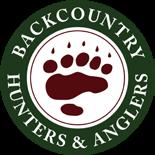
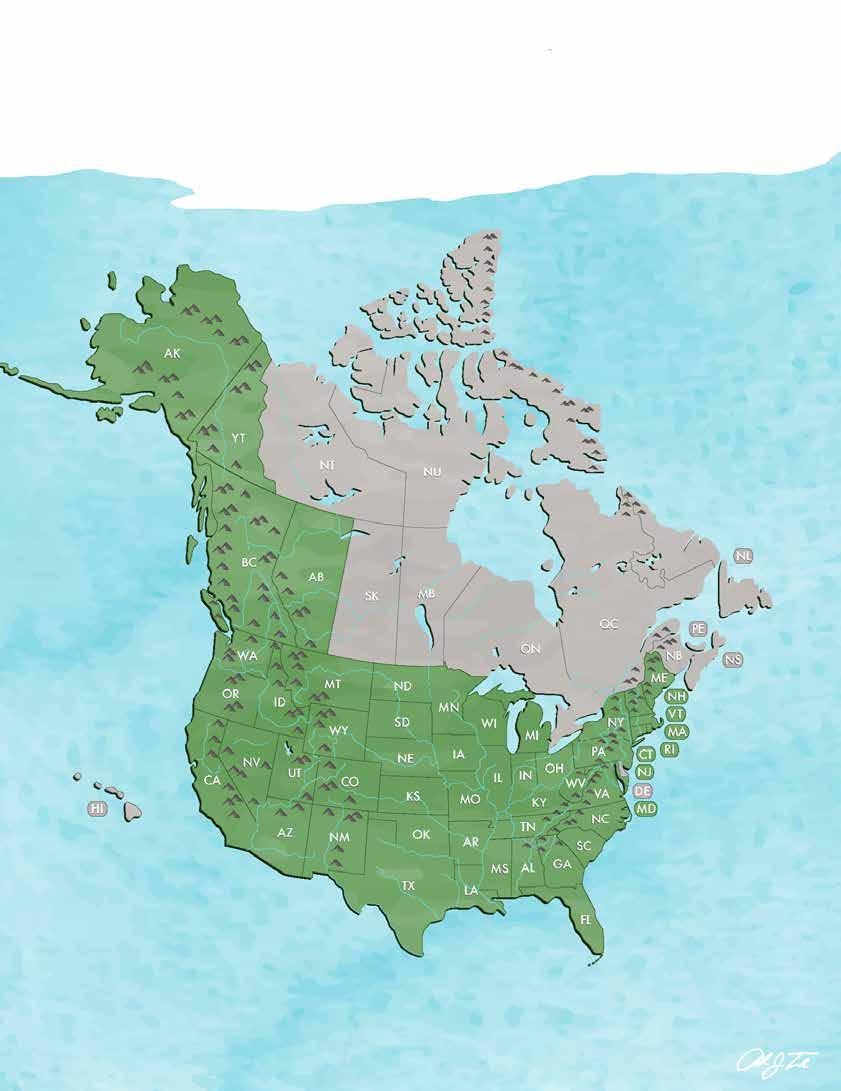
• In advance of the May 2023 provincial elections, the chapter polled membership on issues of concern to bring forward to candidates for office and to help guide chapter engagement with the government going forward.
• The annual Alberta Rendezvous is planned for June 2-4, 2023, at the Alford Lake Conservation Centre.
• The chapter hosted a film and pint night in Edmonton on April 19 in cooperation with Elements Outfitters and Patagonia.
• The second annual Black Bear Bonanza, the most attended BHA event ever outside of a North American Rendezvous, achieved 850 attendees, 84 memberships sold and net revenue of approximately $30,000.
• The second annual Makin Changes in the Drainage event removed more than 150 littered tires (two dump truck loads) from a main drainage in the Ouachita National Forest.
• The chapter hosted a series of events to highlight our public waters, led by new Public Waters Chair Rick Spicer.
• The Armed Forces Initiative is proud to welcome new military installation clubs and leaders, including Jonathon Dotson at Fort Carson, Colorado, and Ryan Young at Seymour Johnson Air Force Base, North Carolina.
• Installation clubs across North America continue to host clinics and camps, engage in conservation projects and add their voice to policy issues critical to the veteran and outdoor community – as AFI continues to grow its members in pursuit of our collective mission in conservation!
• Chapter representatives participated in the Guide Outfitters Association of British Columbia’s Annual General Meeting, meeting with government officials to discuss wildlife concerns and management strategies.
• Volunteers have been busy tabling at outdoor shows throughout the province, promoting BHA values, making valuable connections, recruiting members and holding fundraising raffles.
• Kootenay region leads are engaging with ministry representatives on the development of a new in-depth Elk Stewardship Plan that will also serve as the model for other species management plans.
• The chapter is spearheading a coalition working to create a wildlife overpass for Peninsular bighorn sheep along a deadly stretch of I-8 in southern California.
• BHA authored a coalition letter to CDFW defending access to navigable waters of the state after anglers were confronted with trespass allegations by wardens last November on the Truckee River; CDFW’s legal counsel has since agreed with BHA and has clarified the public right to access!
• The chapter hosted several successful events this year including a New Year, New Zero rifle clinic and a bighorn sheep count with CDFW biologists.
• Colorado co-chair Don Holmstrom was honored with the Sigurd F. Olson award at the 2023 Rendezvous, acknowledging his years of work championing better stream access in Colorado.
• To mark Colorado Public Lands Day, the chapter hosted a weekend-long stewardship event and festival in Gunnison. Thanks to all volunteers and sponsors!
• The chapter appointed Lew French as Central West Slope assistant regional director.
• In March, the Florida chapter launched an action alert campaign in support of HJR 1157 and SJR 1234, which if passed would secure hunting and fishing as a constitutional right in the state of Florida.
• The chapter hosted a booth at this year’s Florida Outdoor Expo for our second year in a row. This year our booth incorporated a workshop for beginners to learn archery.
• The chapter submitted public comment in support of a new proposed conservation area in southwest Florida led by USFWS.
• Tabled at the Idaho Sportsman Show and hosted the International Fly Fishing Film Festival in Boise. The Idaho chapter also hosted pint nights in Moscow and Sandpoint.
• Welcomed Jessica French as the Idaho chapter’s region 7 representative.
• The chapter is “gearing up” for the annual Gear, Deer and Beer consignment sale on June 10 in Boise.
• The chapter is partnering with the Bureau of Land Management on a native revegetation project on Pine Creek Bench in eastern Idaho’s Swan Valley.
• The chapter continues to focus on HB1568 concerning stream access. Please call your local legislator and urge them to vote in favor of this bill.
• We have also hosted several pint nights and participated in the IL Deer Classic. Thank you to all who came out and supported.
• Keep your eyes out for the Illinois chapter archery range project and come on out to join us setting up this first-of-its-kind project.
• The chapter hosted a very successful Field to Table Conservation Night in February. Check out the chapter blog for photos and information. Thanks to the sponsors, attendees and volunteers for making this event!
• Members across the state have been engaged in multiple events from pint nights to stewardship projects and great virtual education events. The Indiana chapter has a packed 2023 event schedule!
• The chapter policy team has been busy advocating for increased funding for the DNR and the protection of Indiana wetlands. Speaking of wetlands, episode 152 of the BHA Podcast & Blast featured the Grand Kankakee Marsh located in Indiana and Illinois – a great podcast that sheds light on the importance of preserving our wetlands!
• The chapter hosted a booth at the 2023 Deer Classic in Des Moines, where the group recruited members, talked about upcoming policy and held a raffle.
• The chapter is fighting to protect public land in Iowa against Senate File 516, which would shift DNR’s focus from acquiring new public land to maintaining current public land.
• The chapter contributed to the acquisition of a new public fishing pond and hunting ground in Lyon County.
• In February, Kansas chapter volunteers assisted with the Border Wars Archery Tournament held in Johnson County.
• In March, the Kansas chapter held its annual member sporting clays shoot at Powder Creek Shooting Park in Lenexa.
• In March, the Kansas chapter shared a vendor booth with the Missouri chapter at the Opens Seasons Sportsman Expo held at the Overland Park Convention Center in Overland Park, Kansas.
• Also in March, volunteers from the Kansas chapter assisted at the Kansas High School State Archery Tournament held in Hutchinson.
• Kentucky started the year with four successful Conservation Coffees, spotlighting not only what we did last and this year but what many other biologists and conservation groups are doing as well.
• We successfully tabled at a gun show and a preparedness expo.
• We held a virtual turkey talk with success!
• We held our first successful trap shoot fundraiser called the Herbert Mackey Memorial Sine Die Shootout, where we had 20 shooters and 30-plus in the crowd.
• The Michigan chapter spent the winter boosting awareness and support for a historic fishing location, created specifically for recreation access and fishing, that may be closing – Cornwall Dam in the Pigeon Flooding area. The dam is in dire need of repair, and supportive individuals and organizations are trying to find methods to save this structure.
• The chapter hosted a pint night to show opposition to a military base expansion. If approved, the expansion could possibly affect opportunities on thousands of acres of Michigan public lands.
• The Michigan chapter is planning their annual Michigan Rendezvous for July 28-30! This event always brings members together for a great weekend of networking, education and fun centered around conservation! Visit backcountryhunters.org/michigan for more on chapter events.
• The chapter welcomed longtime, dedicated member Neal Jacobson to its chapter board! The chapter would also like to give a HUGE thank you to Bob Mahrer for donating the dark house spearing trip and state sponsor Hjelle-Arc for donating a custom BHA spear for the North American Rendezvous online auction.
• The UMN BHA collegiate club successfully held a Hunting for Sustainability turkey hunt near Nisswa over two days. They raised funds to support this event through raffles and with the help of G&H Decoys.
• Chapter board members testified before the legislature three times in support of public lands funding!
• We have upcoming pint nights at Unmapped and Bemidji Brewing. We have a booth at the Minnesota Game Fair in Anoka on Aug. 11-13 and 18-20. Come check it out!
• The Missouri chapter recently held a successful pint night with special guest Land Tawney in St. Louis!
• The Missouri chapter kicked off their monthly archery shoot in St. Louis with some awesome prizes up for grabs! Please check the events section of the website for more details on all of our upcoming events.
• The Missouri chapter announced they will be partnering with Mark Kenyon of Wired To Hunt and MeatEater as part of the Working for Wildlife Tour Aug. 1!
• Engaged in over 40 bills during Montana’s 90-day legislative session, providing testimony, sending action alerts and highlighting legislation dealing with conservation funding, public access, clean water, equitable wildlife management and more.
• Hosted a pint night in Three Forks, shooting range cleanup in Belgrade and IF4 screening in Missoula.
• Celebrated as two Montanans, Andrew McKean and chapter board member Corey Ellis, were honored during BHA’s annual awards ceremony. More in HQ News on page 13.
• The chapter held a joint pint night in Las Vegas with Quail Forever.
• The chapter hosted a tag application seminar in Reno with Nevada Division of Wildlife biologists and instructors.
• The chapter commented on various legislative actions in support of wildlife crossings and wild horse management and opposed bills banning hunting contests and changing the wildlife commission.
• The chapter joined staff from the Gila National Forest to remove an old fence in the Gila Wilderness. Together, they staged for removal 1.5 miles of wire fencing.
• For the third consecutive year, the chapter worked to improve pronghorn habitat on the Kiowa National Grasslands by raising and replacing bottom strands of barbwire fencing to facilitate pronghorn movement and minimize injury risk.
• The chapter performed a Rio Grande river cleanup near Algodones.
• The chapter and AFI teamed up for a Duck Box Build pint night. The AFI team is working with the DEC to install those boxes on public land.
• The chapter and NY Hunters of Color teamed up on a Duck Box and Brews pint night at the Filson NYC store. The boxes will be installed in a local marsh at an upcoming event.
• Chapter members gathered for a pint night in Brooklyn to celebrate a book release by BHA member Brant MacDuff. Brant read an excerpt from The Shotgun Conservationist, and a few members won raffle prizes from chapter sponsor Quaker Boy.
• The hard work from the chapter paid off for sportsmen and women this legislative session, namely the defeat of HB 1151, which would have taken the Game and Fish Department’s ability to implement game management plans by prohibiting baiting.
• The chapter partnered with the North Dakota Game & Fish Department to renovate and reopen the Sundheim Boat Ramp, providing access to the Little Yellowstone River.
• The chapter is submitting comment on the state’s BLM resource management plan.
• The Ohio chapter is excited to announce our biggest event yet: Muster in the Marsh! This outdoor extravaganza will be held on July 21-23 at Covered Bridge Outfitters near Conneaut and will feature a variety of activities, great food and drink, music and tales of the outdoors. We hope to see you there! Visit backcountryhunters.org/ohio to keep up to date on chapter events.
• The chapter has been active, with recent events at the Columbus Sportsman’s Expo and a fish attractor structure placing event with the Ohio Division of Wildlife at Rocky Fork Lake, along with upcoming foraging walks, tree plantings and macroinvertebrate samplings.
• It is abundantly clear now that the “Chicken Bill,” HB 507, has been constructed to subvert public comment, and there is a window before regulatory mechanisms become active that appears to allow no comment by the public on leasing of public lands by oil and gas concerns. All activity on public land should be subject to public scrutiny, and we are fighting to maintain this basic principle here in Ohio.
• In March, the Oklahoma chapter partnered with wildlife department biologists at Heyburn WMA to plant 275 trees and applied herbicide granular spike to return certain areas to warm-season grasses. This event marks the third year the chapter has partnered with ODWC at Heyburn WMA for habitat improvement.
• The Oklahoma chapter has established its own Armed Forces Initiative program. More information can be found on social channels.
• On May 16, the Oklahoma chapter hosted a pint night at Heirloom Ales in Tulsa.
• The Oregon chapter just came off of a great event in April with their second Cut and Cook event. With a group of 50-plus, they broke down turkeys and managed to cook up some incredible table fare to share with eager participants.
• The Oregon chapter has prioritized the right to hunt and fish in its current legislation work. With the initiative still in play, they are working diligently to gain support across the state.
• For the second time this year, Pennsylvania members spent the day removing invasive species from State Game Lands 52. The project is a continuing effort by the chapter, and future events are being planned.
• The chapter held pint nights across the state.
• Board members joined other conservation groups and met with legislators in Harrisburg for the sportsmen’s and women’s working policy group day on the hill. This has become a yearly event where the participating groups come together to represent a united front on conservation issues in Pennsylvania.
• The chapter intends on fighting, based on environmental and cultural zoning guidelines, a new proposal to develop a golf course on Pine Island. This development would negatively impact wildlife in the area.
• Sunday hunting on public land remains the top priority for our chapter. Our efforts to push this legislation through will begin again this spring.
• The chapter plans to incorporate new leaders with fresh ideas into the organization as long-standing leaders retire from the board.
• The chapter elected new leaders for 2023, including Rochelle Plocek as board chair and William Busse as secretary.
• The chapter is monitoring and commenting on proposed mining activity across the Black Hills National Forest in western South Dakota and a pumped storage proposal for Lake Frances Case in southeastern South Dakota.
• Spring and summer work events are being scheduled around the state. Keep an eye out for emails with more information.
• The Texas chapter of BHA was awarded the George Bird Grinnell Award at the BHA North American Rendezvous for chapter of the year!
• The chapter organized a cleanup at the Lake Grapevine public hunt area with the U.S. Army Corps of Engineers and Texas Bowhunter members and removed around 6,500 pounds of waste.
• The chapter held an event at Dai Due in Austin with chef/owner Jesse Griffiths, Executive Director of Devils River Conservancy Romey Swanson and Executive Director of Texas Foundation for Conservation John Shepperd.
• The chapter encouraged members to submit public input for the 2024 Land & Water plan for future TPWD management.
• The Utah chapter partnered with the International Fly Fishing Film Festival to host a sold-out film showing in Salt Lake City.
• The chapter held a general chapter meeting at Western Rivers Fly Fisher to discuss upcoming chapter events for 2023 and recap the legislative session.
• The second Utah Hunting for Sustainability workshop series kicked off this spring with 15 new adult hunters.
WASHINGTON
• The chapter continues to work with its conservation coailtion to identify areas of opportunity in the state legislative session. Currently, a lot of the attention is still falling on the WDFW commission as it has recently added new members to the governing body.
• The chapter looks forward to an eventful spring and summer, starting off with the annual Mathow Valley fence removal and annual archery shoot in Belfair.
• Efforts to expand OHV recreation to state forests and state parks were squashed with a House amendment to S.B. 468. The bill did pass and allows for the OHV recreation pilot program at Cabwaylingo State Forest to remain as a permanent feature but prohibits further expansion. Unfortunately, WMAs were not included in the protections.
• The chapter was busy this winter adding new board members, tabling expos and growing the chapter. The chapter’s presence is increasing throughout the state.
• Stay tuned to our e-newsletter and social channels for upcoming chapter events.
• The Wisconsin chapter board is busy finalizing the 2023 Wisconsin Rendezvous, which will be held on Aug. 5 at Rib Mountain Bowmen. Mark your calendars; we look forward to seeing everyone around the campfire!
• Wisconsin Chapter Policy Chair Paul Schecklman met with Wisconsin DNR Secretary Adam Payne to discuss public lands issues and other DNR concerns. Secretary Payne was receptive to comments and concerns brought forward by the chapter.
• Wisconsin Chapter Board Chair Joe Steffen and board member Brock Rosenkranz attended chapter leadership training and represented the chapter in Missoula for Rendezvous.
• Co-chairman Buzz Hettick won the 2023 Mike Beagle-Chairman’s Award for his outstanding efforts on behalf of BHA. Congrats, Buzz!
• A major win in Cheyenne: House Bill 147 passed, which made it illegal to post or maintain signs that improperly restrict access to state or federal lands on which lawful taking of wildlife is permitted. Many thanks to Sabrina King for all her hard work this legislative session!
• Tim Brass spoke about corner crossing at the UW Berry Biodiversity Center in March. We’ll have more corner crossing updates in the coming months.
Find a more detailed writeup of your chapter’s news along with events and updates by regularly visiting www.backcountryhunters.org/chapters or contacting them at [your state/province/territory/region]@backcountryhunters.org (e.g. newengland@backcountryhunters.org)
The students of BHA’s Collegiate Program continue to impress. Here’s some highlights of the good work our college clubs have been up to.
The Public Land Owner Stewardship Fund, supported by the S. Kent Rockwell Foundation, continues to be one of the collegiate program’s most successful initiatives, and we wrapped up our third year of the program this spring. Last fall, five clubs applied for and received funding to support public lands and waters stewardship projects. From trash pack outs and building nest boxes to helping set up camera traps and restoring grassland habitat, our clubs made major impacts on the ground in partnership with state agencies and local conservation organizations. Washington State University built and installed several nest boxes for the American kestrel in partnership with the Phoenix Conservancy. “Our primary goal was to set up nest boxes for American kestrels, which we did,” said Club President Rebekah Hellesto, “but we also set up a bat box, several native bee nest boxes and learned about the invasive species in the area, native prairie plants, and how all of these species interact with each other.”
Club leader Evan Barnes added, “Participating in conservation at a local scale is a really easy way to make noticeable differences in your area and is something that I believe everyone passionate enough to do so should have a part in!” We look forward to offering another five grants to deserving clubs this fall.
This spring, University of Montana club leaders Joe Graff and Claire McAtee played hooky to join BHA in Helena for a day at


the Montana Capitol. They spent the morning braving below zero temperatures at the Public Lands Rally, where speakers provided unique inspiration and reminders on why it’s so important that we continue to fight for our wild public lands, waters and wildlife. Following the rally, Claire and Joe traded their Carhartts for business casual and took a tour of the Capitol, viewed the Senate and House floor sessions and watched BHA give testimony at a committee hearing.
Former University of Wisconsin Stevens Point Club President Harrison Stasik accompanied BHA President and CEO Land Tawney on a trip to D.C., where he attended meetings on the Hill and worked with BHA policy staffers John Gale and Kaden McArthur to learn more about our work at the federal level. From fishing on the Potomac to visiting Wisconsin Rep. Van Orden to meeting his conservation heroes, Steve Rinella and Ryan Callaghan, it’s safe to say this trip won’t soon be forgotten. “As an aspiring conservationist, the time I spent in Washington, D.C., representing BHA was nothing less than monumental,” said Harrison. “This experience was not only educational, but it will continue to inspire me to stand up for public lands and waters for many years to come.”
Experiences on public lands and waters drive the desire to advocate, which is why BHA continues to provide new outdoors experiences through our Hunting for Sustainability workshops. Stevens Point and the University of Minnesota hosted their second annual turkey workshops after successful workshops in 2022. Murray State University hosted their first Hunting for Sustainability turkey workshop this spring with support from the Kentucky chapter and club advisor, Dr. Whiteman. Turkeys were a popular subject among our college clubs this spring, with other clubs hosting turkey speakers, seminars and even box call builds. BHA corporate sponsor G&H Decoys continued their generous support of the program by donating decoys sets to support these events.
Over 30 students attended this year’s North American Rendezvous
in Missoula, Montana. Rendezvous offers the unique opportunity for student leaders to come together in what can sometimes feel like lonely and difficult work – running a university club is no easy task. The chance to spend a weekend with the BHA community serves to spur ideas, create friendships and ignite passions to continue their work for our public lands. Students participated in chapter leader training, volunteered at the Field to Table dinner, competed in the wild game cookoff and networked with conservation leaders. The University of Idaho was well represented with a crew of eight, who showed their backcountry spirits by camping together in a wall tent for the weekend. “Rendezvous was an amazing experience, and meeting other people who have the same conservation goal was rewarding,” said University of Idaho Club President Jacob Young. “Having our home base in a wall tent was the best idea … and we are looking forward to next year.”
In our program, the quote “all good things must come to an end” rings all too true every spring semester as we celebrate the bittersweet graduations of some of our best leaders. This semester, we bid farewell to Harrison Stasik, Rebekah Hellesto and Nicole Bealer, who have put in years of hard work for BHA. Their clubs are some of the most active and engaged in our program. However, the goal of this program has always been to foster conservation leaders, and we’re confident that we haven’t seen the last of these three. By the time this issue reaches your hands, Nicole will be working for Montana Fish, Wildlife and Parks studying bighorn

sheep; Rebekah will be off the grid through-hiking the Pacific Crest Trail; and Harrison will likely be working in the conservation space, lending his knack for wildlife, public lands and communication to a worthy cause. For us, it’s not goodbye – it’s “see you later,” as we look forward to working with them in their professional roles.
As students wrap up finals and travel across the country for summer jobs, we wish them abundant public land and water adventures that will fuel them for another busy fall. -Kylie


 Schumacher
Schumacher
If you were to drive the speed limit past my modest house in a trendy Appalachian mountain town in western North Carolina, you’d probably not give it a second glance.
If you parked and walked to the front door, that’s when things might get interesting if you’re the type of person that notices things. A whirl of duck down dancing across the front deck. A fan of reishi mushrooms drying in the sun. A stubborn blood stain darkening the concrete walkway. The glint of dried fish scales stuck to the rhododendron leaves.
What you’d shortly come to realize – because I’ve become the sort of person to tell you up front – is that you’d dropped in on a home where the detritus of a hunting, fishing and gathering lifestyle changes with the seasons but never goes away.
That all of this plucking, drying, skinning, scaling, hanging and processing takes place amid a densely developed, undeniably suburban and diverse neighborhood of dyed-in-the-wool supermarket shoppers is cause for plenty of curious stares from the morning dog walkers and young couples pushing baby strollers. It’s also an opportunity to educate folks who don’t engage in or think about such activities.
When we moved to this house 12 years ago, I soon found myself wandering around the small yard in search of a suitable deerhanging tree. A few months later, I still hadn’t found it and the doe in the bed of the pickup needed to be skinned and dressed sooner than later.
Our new, non-hunting nextdoor neighbors had a perfect spot to screw in an eye hook to support the necessary block and tackle for the job underneath their elevated deck. I don’t know if they acquiesced in the spirit of solidarity, curiosity or to end the awkward and uncomfortable pitch I was making, but in a few minutes we had
her strung up for all the world to see and with company soon to arrive on the day before Christmas. And while most of us reading magazine articles like this might be blind to the desire of some to avoid such a collision of holiday symbolism, to their everlasting credit, that young couple embraced the opportunity of a dead deer hanging from their house on Christmas Eve to embark on their own journey of learning to harvest animals, turn them into meat and honor them as food.
A few weeks later we invited them over to our place for the first time. We’d be eating venison of course, but I’d also prompted them to choose a sausage we could make together and gift to them as a thank you. We ground and stuffed 5 pounds of Hawaiian linguica that afternoon and then dined on seared backstrap with a balsamic reduction and roasted vegetables that evening.
For me, the desperate act of asking permission from an unlikely benefactor has led to years of fulfillment as a mentor, guiding them through a new world of hunting and gathering. We all enjoyed the venison from the doe that winter, but that deer also sparked lasting friendship that we cherish to this day.

We are constantly reminded that recruiting new hunters may be the modern salvation of our shared obsession, but there’s no shame in moving the needle by smaller increments. I often meet people for the first time who will admit they haven’t ever before spoken to someone who hunts. That being the case, how then are we to expect non-hunters to throw their support behind issues of wildlife management, public lands and traditional use of natural resources if they’ve never engaged with anyone who cares deeply about it? Explaining the how and the why can be a critical first step in giving these folks the information they need to make decisions on future policies.
While most of the animal processing that takes place at my house is of the wild varieties, I have also come to be known as the guy who
takes care of the unwanted chickens (surprise roosters) they didn’t sign up for when they bought a half-dozen guaranteed laying hens at the local feed and seed.
When I answer these calls, it’s typical for there to be a brace of colorful cockerels hanging from the handle of the garage door the next morning while I’m inside gathering the implements I need to pluck, gut and part out the birds. This scene can take place any time of the year, so when a neighbor from down the street mentioned that he’d noticed I’d had a successful “duck” hunt I had to pause, considering it was June. The conversation that ensued included an eye-opening revelation to him that there are rules that govern hunting, including seasons, limits, allowable methods and duties to report. That it would have been illegal for me to hunt ducks during the summer was a surprise and a relief.
It reminded me the language of hunting and fishing regulations is not top-of-mind for the general public. Many folks are completely unaware that state and federal fish and game agencies set the framework for sustainable harvest of natural resources, which balances healthy populations with opportunities for reasonable limits for personal use. I can tell you that in that brief, 20-minute encounter, my neighbor went from the false assumption that hunters wandered the woods 365 days a year shooting as many critters as they pleased to a rudimentary understanding that those who would pursue wildlife must do so within a strict set of guidelines or face legal consequences. I could practically see the recalibration of his mindset taking place.
With two house dogs that need to be walked every day, my wife and I have a pretty good finger on the pulse of what’s growing along our usual routes throughout the town. Grape vines provide leaves for rolling dolmas. Some feral sage plants are picked when sausagemaking season is in. Mushrooms are a fairly new obsession for us, and we still can’t get over the idea that such amazing foods can be gathered from virtually any habitat, including Bermuda grass lawns, manicured landscaping, tree stumps and even gravel driveways. It was during one of these daily dog walks that I spotted the mushroom hunter’s dream in a yard up the street. At the base of an oak stump, a cluster of bright orange fan-shaped fungus, called chicken-of-thewoods, had emerged. It was my first found chicken-of-the-woods since we’d started our mushroom hunting journey and I stared at it hungrily from the street. There was no question the fungus was on private property. I just had to work up the gumption to ask for it. So I took the dogs back to the house and grabbed a brown paper grocery bag in the hopes the answer would be yes. Before I started down the owner’s driveway I stashed the bag in a bush so as not to seem presumptuous.
An elderly man answered the door and I made my pitch. “Hello there. I’m Jamie, and I live in the neighborhood and walk by your house when I walk my dogs. I happened to notice a big mushroom growing out of your tree stump in the side yard, and it’s one that is good to eat. If you’re not planning to eat it, do you think I could have it?”
He took it in stride and said, “You say it’s good to eat, eh. Well, we’d better have a look at it then.”
I got my mushroom that day, but I also got invited inside for a cup of coffee. I learned my neighbor was recently widowed and that he and his wife had lived in this town for 30 years. He’d immigrated to the United States from Denmark during the 90s and was an architect. In fact, he’d designed and built the house we were sitting
in. Since his retirement, he’d taken up the master craft of building and refurbishing large weaving looms and would I like to see the one he had in the next room.
My visit lasted a lot longer than the time it took to get permission to harvest a mushroom, but it certainly was time well spent. If not for that chicken-of-the-woods, I still wouldn’t know this incredibly fascinating man who lived just a few blocks away. Nor would I have an open invitation to harvest whatever plant or fungus that struck my fancy on his property and to stop in for coffee and a chat.
There are folks who have passed judgment on hunters and fishers without ever taking the time to talk to one of us to find out why we do what we do. But, for every one that disapproves, there is another who is curious and just hasn’t had the opportunity to ask. I could argue that we hunters have found ourselves at a crossroads. On the path to the right, we see hunter participation declining at an alarming rate and wonder what the future holds for the dwindling number of us in which the flame burns bright. On the path to the left, we see a growing interest in sustainable food production and a renewed emphasis on knowing where the food on the dinner plate came from.
Hunting, fishing and foraging can be the centerpiece at this table of welcome strangers who don’t come from the same starting point. We don’t get a future if we circle the wagons and hide. The future lies in our ability to engage, invite and encourage participation from groups and communities that don’t fit the traditional expectations of those who hunt and those who don’t. That engagement can start with the people next door.
BHA life member Jamie Cameron is a North Carolina state park ranger. As such, his duties include natural resources management, law enforcement, search and rescue and wildland firefighting. His passion lies in opportunities to educate young people about the outdoors and teach them to become stewards of the land.
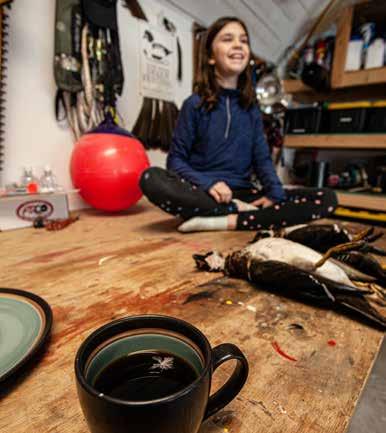

What do a business manager, a death doula/massage therapist, and a water engineer have in common?
Maybe not a whole lot, but they’ve all expressed curiosity around game, anatomy, hunting or butchery.
The stereotype of the rugged, lone hunter is over. In its place could be a mirror, reflecting you, reflecting me and every difference among us. Hunter diversity is growing as we media, photographers and writers showcase diversity too – beyond the stalk and the kill.
As with many endeavors, the possibilities for success increase when we open ourselves to community. I couldn’t hunt without help or mentors. Still learning every day, I gain new skills when I’m humble – sharing and learning from my failures, and listening to other hunter’s stories. I consider where to hunt, sharing beta with fellow hunters and landowners. I dry-age game in a farmer’s walkin cooler. I butcher in a rancher’s barn; grind sausage in a friend’s basement. And with no chest freezer, I share most of it, storing my share among their freezers.
My friend Jay helped me secure a salvage permit elk not too long ago. The cow had jumped an irrigation canal and impaled herself on an abandoned t-post. He watched her stagger to a warm spot on the sunny side of a thicket, and die in the snow. After I gutted and
quartered her, my friend and fellow farmer, Erin, offered me access to her greenhouse to butcher in comfort. With such ideal digs, I turned tragedy into opportunity, inviting friends to butcher.
The first to join, Crystal, is above all, sheer effervescence. Business manager, climber, angler, river rat. She creates beauty the way other people blink or breathe. Unless she’s in Carhartts or her Artemis ballcap, you’d never guess she’s on fire to learn to hunt. I invited her to play.
“Oh, my gosh, hard ‘yes,’” she exclaimed.
We met at Erin’s Acres where she helped me haul a hind quarter from the walk-in to the greenhouse. Inside, the air was fecund, rich with the scent of soil and living plants in the middle of winter. Warmth and moisture enveloped us as we set up on produce tables and spread out over cutting boards.

I started hunting at 30 – 15 years after my initial aspirations. That’s how long it took just to break in. I was initiated on an illegally guided drop camp (I know! I was new. I had no idea.) with six alpha males. I was the cook and never even got to leave camp. My own first elk season followed. I borrowed a beat up .30-06 with iron sights. By last light on day five, I accepted defeat as a blessing – I had no idea how to gut an elk!
How does one learn, without help? There’s always YouTube, but as any hunter will tell you, it’s just not the same. Since my first fiasco
of a hunt, and a handful after, I wonder today if I hadn’t maybe sabotaged those hunts through a subconscious fear (dread) of the unknown. Killing and slaughtering a 700-pound animal is a big effing deal.
As an Artemis ambassador at the time I salvaged the t-post cow elk, it was my role to dispel fears, share knowledge, and help get women and girls in the field. I knew Crystal wanted hands-on experience.
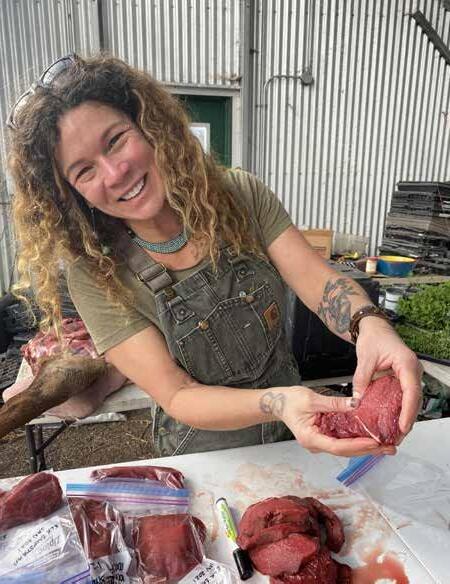
We laid out the quarter, sharpened our knives, and Crystal was on it.
“I’m a biology major and did tons of cadaver labs; I’m fascinated with this. And then the whole Artemis thing – hunting and women, being more intimate with our food source – I’ve never done that. I wanna know –” she bursts out “– how does my background in biology correlate to this interest in hunting, how you execute and pull through, to the end.”
What I would have done for moments like this before heading into the backcountry my first time. To learn beforehand that this wasn’t gross, or stinky, but crazy fascinating.
“It was very cool!” Crystal says. “It was like, ‘WOW. That tendon makes that part of her leg move!’ It was very ‘sciencey,’ you know? The smell was primal and raw. Sweet and bright; fresh. Seeing the fascia, the flesh. It felt natural – it was an intense process, but intuitive.”
Before her brother died ice climbing, he had also been a hunter. Crystal had helped him grind meat, but she had never actually hunted with him. “We’d talk, I’d help with smaller projects, but never like this,” she says.
Now, she’s had an afternoon of butchering under her belt and a few pounds of backstrap in her purse.
As a massage therapist, my friend Jeet has a thorough understanding of the human body and how muscles, tendons and bones work and move together – but only on the outside. I thought she’d get a kick out of seeing it from the inside. And from time to time, a client gives her elk summer sausage or whitetail steaks. Not knowing how to cook a prime cut, she passed that epicurean delight on to me. In the span of our friendship, though, she’s gained more confidence cooking and eating prime cuts.
She bravely, tentatively accepted my invitation to butcher.
“I was terrified, actually!” she chuckles. “I thought, ‘I don’t think I’m ready for this.’ We’ve talked about it a lot. I’d heard about it from you, from my hunting clients. I was petrified, and I thought, ‘Nope! I’m gonna be brave.’”
I promised her she didn’t have to butcher; she could just watch. I laid out a front quarter and a backstrap. Put on some easy tunes. And she watched me skin, mostly geeking out on the visuals. With the hide off, she felt able to jump in, separating muscles and cleaning fascia.
“I was mind blown at that Achilles tendon, how absolutely thick it was!” she says. Like Crystal, anatomy was the real kicker. “It was just incredible to see how it all came together!”
Jeet grew up vegetarian in a Sikh ashram in Baltimore and went to boarding school in the Himalayas through her junior year of high school. She started yoga at 2 years old and has deep personal
practice that parlays into every aspect of her life. That attention has turned her into a competent fly fisher, catching and cooking trout for her and her daughter, and backpacking. Her family harvested a few of their pet quail and ate those, too. This elk was her first time playing with big game.
“We have a good, incredible history as friends. I’ve always admired your hunting skills,” she says, of attempting to butcher the elk. “So much of this is sharing something with you that’s a part of you, and wanting to share in the intimacy of that experience with you – what makes you tick, what you’re passionate about.”
In her work as a death doula, Jeet prepares people for the ultimate rite of passage in a culture that has lost sight of rites of passage. As women, the archetypal nurturers of life, and as moms, Jeet and I have a Rites of Passage group together in which we honor and explore life’s passages with our daughters. For me, hunting immediately revealed itself to be all about rites of passage. Death has become a theme in our friendship.
“I wasn’t eagerly looking for the opportunity to help butcher. But when you offered, I thought, ‘This is a powerful experience,’” she says. “To share in what you do, and how you see the world, see life and death.”
While we butchered, I explained what we were doing, separating
the muscle bundles; why we did certain things, like removing oxidized tissue or tough silver skin; how dry aging impacted texture and flavor. And we talked about cooking and grilling.

“It took courage to cook it!” she laughs. “I want to give it so much honor, I want to respect it by not ruining it. That was intimidating. I feel like a braver person now. I felt like I became privy to a secret world!”
We’re all well aware that hunting sometimes gets a bad rap among some non-hunting segments of the population. A few rotten apples reflect poorly on the rest of us. It’s important for hunters to share the positive aspects of our lifestyle with non-hunters. Sharing meat is ideal.
“When I take that meat into my body, I really set prayer,” she says, “and the intention of gratitude for the nourishment, for that animal; honoring it. And I tell my family where this animal came from, and maybe the hunting story so they honor it, too.”
The experience we shared that afternoon took her out of her comfort zone, but the time shared brings one more advocate for hunting to the table. Because of that afternoon, when I offered her
some roadkill venison I smoked, she knew the treasure I offered. She’s a convert now.
My friend Jorge is a logistical thinker, especially as a water engineer living in the Colorado Rockies. Our namesake watershed is in crisis because of our human activity. He, too, is primarily vegetarian out of concern for the world and our human impact on it – which is also why I raise hens. Their eggs are low impact, super clean and easy, immediate protein. But living in town at the time, roosters were against code. When Rudy started to crow, I broke his neck and brined him for Thanksgiving. Succulent, sweet, almost nutty like grouse – Jorge The Vegetarian and I devoured Rudy.
“Harvesting roadkill – or fence kill, like this cow elk – is awesome,” Jorge says, “and when done with reverence, as you do, I was glad to help.”
Obviously not a hunter, Jorge grew up on the Western Slope, surrounded by hunter culture and hunting friends.
“I’d field dressed elk and deer before but had never butchered, so it was cool to learn new things and skills,” he says. “It wasn’t weird or gross for me – most of us are so far removed from our food sources, so it’s great to help get the meat from the field to the table.”
It was fun for me to close that circle with him, and take it even further. That same winter, a neighbor would swing by my house and leave wrapped parcels or Tupperwares of brined duck breasts or Canada geese on the porch or back stoop, like little offerings. I cooked these with Jorge, too, and we had many an excellent meal (despite him being vegetarian!). So when he helped butcher the elk, I brined and smoked some for Thanksgiving again – closing another circle.
“Eating an animal, wild or raised on local grazing,” he concludes, “connects us to our local community in special ways, spiritually and bodily. That smoked elk you prepared for Thanksgiving was the best meat I’ve ever had, certainly, and probably one of the tastiest meals of my life.”
I was gifted an elk by someone I interviewed as a journalist. Without Jay’s generosity, I would not have had elk in my freezer that winter. The elk’s excruciating and tragic death became three afternoons with three never-evers and three more voices advocating for hunting. It would have taken me a week to butcher alone.
It’s too easy to stay in our comfort zones and our cliques, and doing so only limits us.
WITH
INTRODUCING THE NEW GORE-TEX BOUNDARY WADER COLLECTION




 BY E. DONNALL THOMAS JR.
BY E. DONNALL THOMAS JR.
Imagine returning from a 10-day backpack sheep hunt. After several days at home, you begin to experience abdominal pain and troublesome diarrhea. Having experienced bouts of self-limited “stomach flu” in the past, you follow a clear liquid diet and give your symptoms time to resolve on their own. When they don’t, you trudge off to your primary care physician and learn that you have contracted giardiasis.
As Ben Franklin once observed, an ounce of prevention is worth a pound of cure. Let’s review illnesses caused by drinking unpurified water and means of preventing them on your next trip into the backcountry.
The infectious agents that cause illness after exposure to unpurified water fall into one of four categories: parasites, protozoa, bacteria, and viruses. Since infection with large parasites like tapeworms is rarely transmitted by water in North America, I won’t discuss them here. However, travelers to tropical developing nations should get advice from an experienced physician or a travel medicine clinic prior to departure.
Drinking water contaminated by these small, unicellular parasites can expose travelers to a wide variety of infections in the tropics. I’ll focus on the organism most likely to sicken backcountry travelers in North America: giardia.
Giardiasis is usually caused by drinking water contaminated by fecal matter from a variety of wild animals, although pets and people can also transmit the organism. The common term “beaver fever”
is misleading, since giardia can be transmitted by almost any wild mammal, including marmots and other residents of alpine zones. Water from any segment of a stream downstream from wildlife can be contaminated. Paradoxically, this hardy organism thrives in cold, clear, free-flowing water that looks safe to drink.
Symptoms include diarrhea and upper abdominal pain. Fever and bleeding are unusual and should raise the possibility of another illness requiring medical attention. The incubation period is usually one to two weeks, making symptoms unlikely during a short backcountry trip. Since they may not begin for several weeks after exposure, be sure to mention backcountry travel during medical evaluation no matter how much time has elapsed.
Diagnosis is typically made by examining the stool, but stool tests are often negative in those who have the disease. People with typical symptoms and a suggestive exposure history may be treated without a definite diagnosis. Several medications are safe and highly effective, although these are not the usual antibiotics found in firstaid kits.
Giardiasis rarely causes illness serious enough to require hospitalization, although severe diarrhea can occasionally produce dehydration that warrants IV fluids. Undiagnosed chronic giardiasis can sometimes lead to weight loss.
Smaller than protozoa like giardia, many bacteria can cause illness after drinking water that has been contaminated, usually by human sewage. Cholera can be life threatening, although it is rare in North America. Symptoms from other bacteria range from none to gastro-intestinal complaints like those described for giardiasis to dysentery with fever and bloody diarrhea. Mild cases usually require no treatment other than adequate hydration, but dysentery symptoms should be evaluated medically.
Smaller than the organisms described earlier, viruses are responsible for most cases of common stomach flu. Nausea, vomiting, and diarrhea can cause severe discomfort, but these symptoms usually resolve on their own in a day or two. There is no specific treatment other than maintaining hydration. The incubation period is short, so symptoms can develop during backcountry expeditions. Hepatitis A can also be caused by drinking contaminated water, and it causes lengthier illness. Since immunization is safe and effective, frequent travelers to areas with untreated drinking water should consider it.
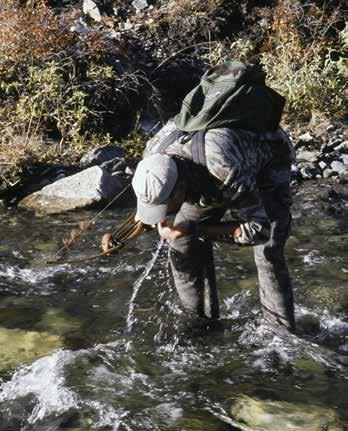
There are four basic ways of purifying water in the backcountry.
This time-honored technique is still valuable. It is particularly effective against giardia, which is highly heat sensitive. Water doesn’t even need to boil to kill giardia. Boiling for one minute will kill most other organisms, although time should be doubled at high altitude. Advantages: safe, effective against all infectious agents, requires no special equipment. Disadvantages: requires heat source.
Compounds containing chlorine or iodine have been used to disinfect water for years. Numerous preparations are available without prescription, and all appear safe in most people when used for short periods of time. They are quite effective against most bacteria, but less so against viruses and protozoa. Water needs to be treated for hours to affect giardia, and cold water reduces effectiveness even more. Mud or other particulate matter can render chemicals less effective. All can leave an unpleasant taste. Pregnant women and people with a history of thyroid disease should avoid iodine compounds. Advantages: convenience. Disadvantages: ineffective against many common organisms, unpleasant aftertaste, waiting time.
Removing infectious agents physically avoids many drawbacks but has limitations. The larger the organism the easier it is to remove by filtration. One-micron mesh will eliminate giardia, while 0.3-micron mesh will be required to remove bacteria. Viruses are too small to filter. The smaller the mesh, the more effective, at the cost of greater susceptibility to clogging by dirty water. Filtration requires careful technique. A few drops of water dribbling around the filter can render the process useless. Many filtration devices are commercially available, ranging in size from large, pressure-driven systems suitable for base camps to individual straws. Advantages: fire unnecessary, no foreign substances or aftertaste, quick and convenient (straws), highly effective against giardia. Disadvantages: ineffective against viruses, requires careful technique, difficult to use in dirty water.
UV will kill many organisms under the right conditions. Marketed under the brand name Steripen, a convenient, lightweight battery powered device emitting UV light at a frequency shown to destroy most bacteria has become an increasingly popular option over the past decade. Its effectiveness against giardia and viruses has not been studied as rigorously, and it requires proper technique. Advantages: light weight, speed, absence of chemicals and aftertaste. Disadvantages: requires batteries/recharge, ineffective in cloudy water.
While drinking contaminated backcountry water can lead to unpleasant symptoms, it rarely causes serious illness in North America. Multiple purification methods of roughly equal effectiveness are available, and choices are a matter of individual preference. However, maintaining adequate hydration is important during vigorous exercise in the backcountry and should not be compromised by concerns about waterborne illness.
BHA life members and Ted Trueblood Award recipients Don Thomas and his wife Lori live in rural Montana. Their kids are grown, replaced by Labrador retrievers and German wirehair pointers. Don writes regularly about fly fishing, wingshooting, bowhunting and wildlife issues for numerous magazines, often accompanied by Lori’s photography. He has just finished his 20th book, “Traditional Bows and Wild Places,” which discusses more wildlife and wilderness material than actual hunting. He is a retired physician with a longstanding interest in wilderness medicine.
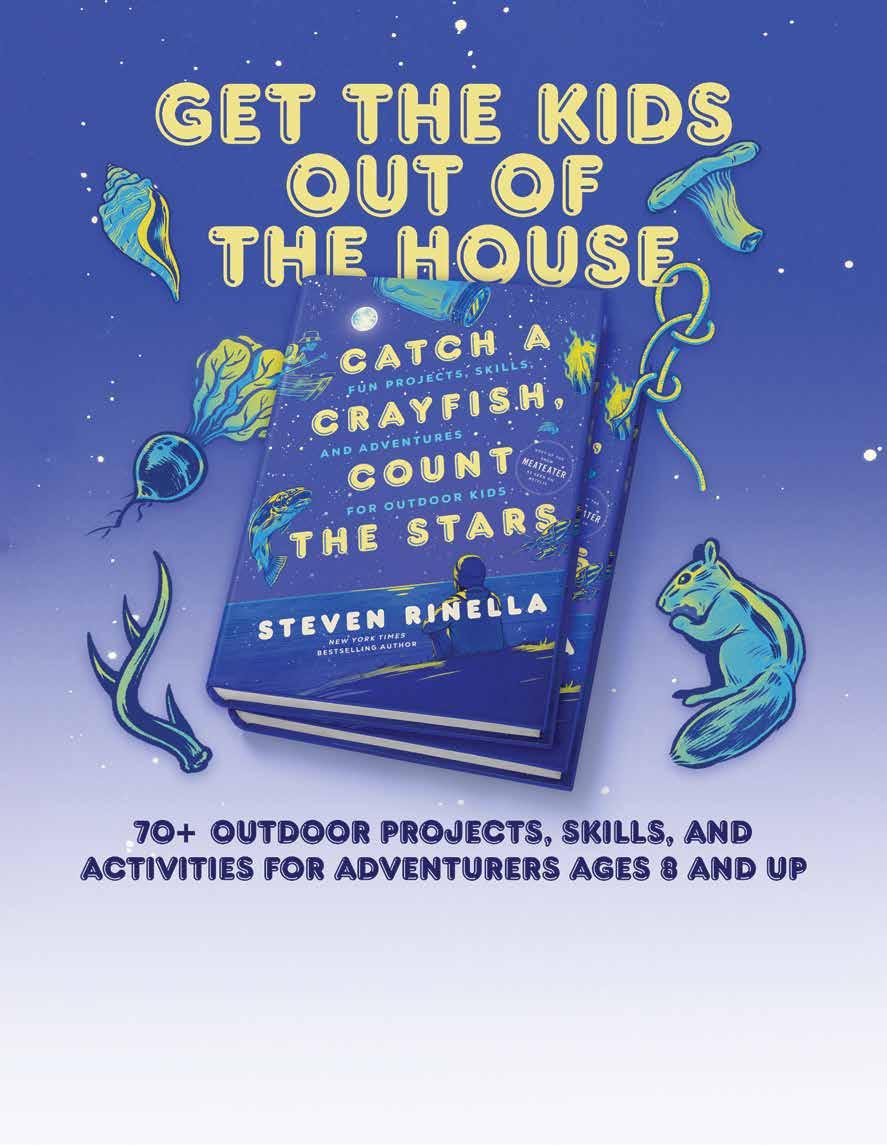


GRAB YOUR COPY WHEREVER BOOKS ARE SOLD.

BHA is, of course, dedicated to “ensuring North America’s outdoor heritage of hunting and fishing in a natural setting, through education and work on behalf of wild public [emphasis added] lands, waters and wildlife.” But it’s also critical to recognize the important role that private lands play in both wildlife conservation and hunting and fishing access opportunities.
The Farm Bill is a multi-year legislative package that impacts every ounce of food and fiber that we consume – regardless of whether those materials are produced here at home or abroad, on public land or private. The 2018 iteration of the bill will expire later this year, so Congress is in the middle of writing a new one. It will have a massive impact on our monthly expenses, our ability to feed and clothe ourselves and our families, where wildlife can survive and thrive and, at least in some cases, where we can hunt or fish.
While the mission and conservation work of BHA are focused on public lands; it’s worth acknowledging that more than 74% of the Lower 48 is privately owned. Broken down further, half of that land-base, or more than 890 million acres, is managed as cropland, pasture or range. And nearly a third of those private lands are forested – often adjacent to public lands. Together, public and private lands are critical for wildlife, providing essential habitat for species we hunt, including migration corridors. Conservation programs in the Farm Bill support rural, agricultural economies that keep lands intact and engaged in responsible production. Plus, they provide habitat for thousands of other wildlife species, as well as those deemed threatened, endangered or “of greatest conservation need.”
For some, the Farm Bill might be more appropriately called a
“food bill” or for others, a “lands bill” or a “commodities bill.” But it’s also a conservation bill, which makes it critical for all of us who care for wildlife and wild places that don’t distinguish between lines on a map. More recently, it has also become an access bill.
The second title of the Farm Bill is comprised of an alphabet soup of programs that pay private landowners for providing some flavor of public benefit, namely cleaner water, cleaner air and wildlife habitat. If you’ve been around the conservation community for a while, you’ll probably recognize a few of the acronyms. All told, the Wetland Reserve Program (WRP), Conservation Reserve Program (CRP), Agricultural Conservation Enhancement Program (ACEP; “A-sep”), Conservation Reserve Enhancement Program (CREP; “Krep” or “C-Rep”), Conservation Stewardship Program (CSP), Regional Conservation Partnership Program (RCPP) and several other programs provide millions of dollars in conservation and restoration activity on private lands annually. To manage and conserve wildlife and wild places at a landscape scale, we need to have all these tools that work across a mosaic of land ownership types.
The Voluntary Public Access and Habitat Improvement Program (VPA-HIP) is another program for landowners – but this one funds programs that incentivize private landowners for providing public access to hunters and anglers on their lands. It was first introduced in the 2008 Farm Bill, and it has been reauthorized in both the 2014 and 2018 bills. Hopefully, VPA-HIP will return, and expand, in this year’s version of the bill.
VPA-HIP is one of the few Farm Bill programs that doesn’t make direct payments to landowners. Here, state and Tribal governments apply to the Natural Resource Conservation Service in the U.S. Department of Agriculture for block grants to improve, grow
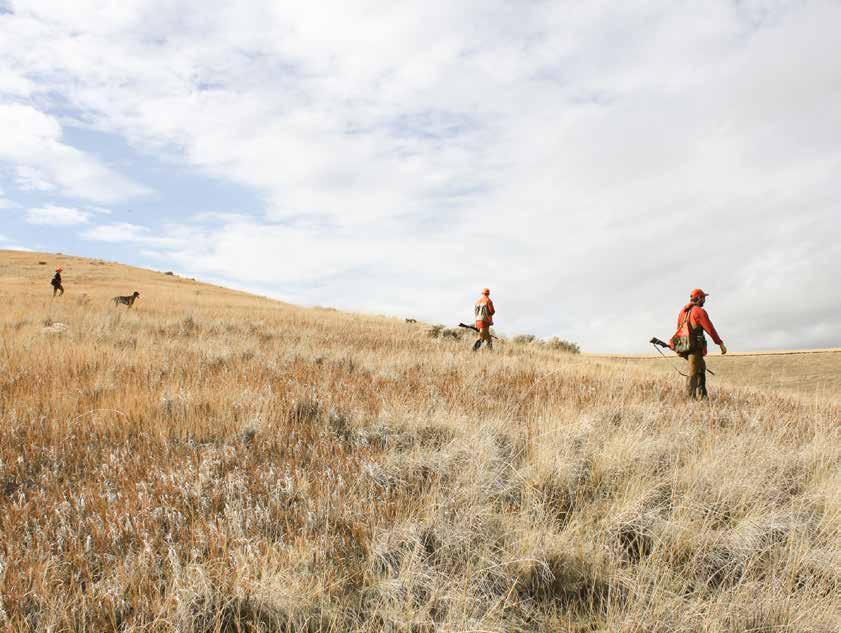
and innovate existing public access programs. Then, the states and Tribes allocate payments to private landowners through locally tailored partnerships. Under this model, funds can be strategically invested by the folks who know the landscapes of their states and their unique constituencies. Congress authorized and appropriated $50 million for this program in the last Farm Bill, which went to programs in more than 25 states.
The program has been so subscribed, and successful, that several hunting, conservation and landowner organizations have asked Congress to increase funding for the program to $150 million in the next Farm Bill – and Sen. Steve Daines (R-MT), Sen. Michael Bennet (D-CO) and Sen. Roger Marshall (R-KS) have introduced the Voluntary Public Access Improvement Act of 2023 (S. 1161) to set the stage for doing just that.
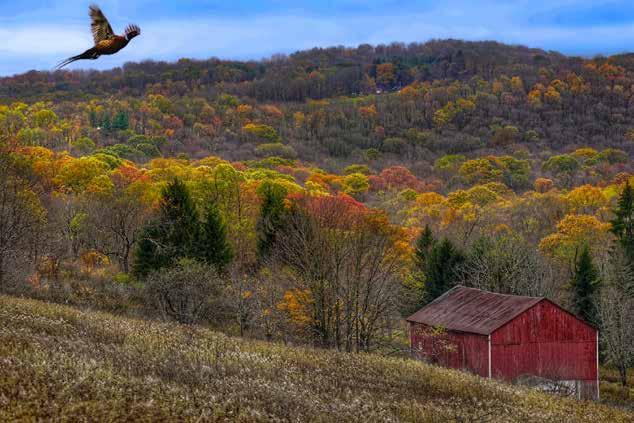
“Public access for hunting and fishing and opportunities for quality experiences are critical for the future of our outdoor traditions,” said John Gale, BHA vice president of policy and government relations. “This legislation under the bipartisan leadership of Sens. Bennet, Daines and Marshall will not only enhance the success of VPAHIP – a proven program that has provided hunters access to nearly one million acres – it will also ensure that states have new resources to expand local partnerships with willing landowners enrolled in programs like Montana’s Block Management Program.”
When BHA polls hunters and anglers, public access and opportunity is consistently at the top of the list of things BHA members ask for more of. With traditional farmers and ranchers operating under historically slim margins, access programs made possible through VPA-HIP are providing unique solutions that simultaneously improve the microeconomics of farming and
ranching while providing public access for hunters who wouldn’t otherwise have it. This thoughtful approach not only delivers on the call from BHA members for enhancing access and opportunity; it also allows us to improve habitat while we’re at it. That’s a win-winwin in my book and an example of commonsense policy outcomes that are becoming increasingly rare in Washington.
There’s something else unique about the Farm Bill and perhaps agriculture policy more broadly in this country.
“The House and Senate Agriculture committees – the committees of jurisdiction for the Farm Bill – mostly still function like the rest of rural America; they work together to help get things done that are good for the farm, not just a political party or the next election,” said James L. Cummins, president of the Boone and Crockett Club. “Their members serve not to make a fuss but to make a difference. And I commend them for resisting the alternative.”
As you’re reading this magazine, the summer growing season will be in full swing, and you’re likely thinking ahead to where you’re going to hunt next fall. At this same time, conservation organizations are working with members of Congress, their staff and professionals at state, Tribal, and federal agencies to make sure we all have access to high-quality places to hunt and fish, regardless of who the land
BHA member Charlie Booher is a conservation lobbyist at Watershed Results LLC and holds degrees in wildlife biology, public policy and natural resource conflict resolution from Michigan State University and the University of Montana. Outside of the office, you can find him hiking the mountains of Western Montana and relearning how to hunt and fish in the Northern Rockies.
belongs to.
When BHA polls hunters and anglers, public access and opportunity is consistently at the top of the list of things BHA members ask for more of.Photo: Brian Halchak, 2022 Public Lands and Waters Photo Contest
Imagine if someone put the same time, thought, and effort into designing fishing apparel that you put into finding fish. Someone did; we’re Skwala. We make thoughtful, dependable, comfortable gear—so meticulously built and thoroughly tested that you hardly notice it. Allowing you to focus on more important things, like fishing.







Every shot has a story, and the best stories start with Savage.

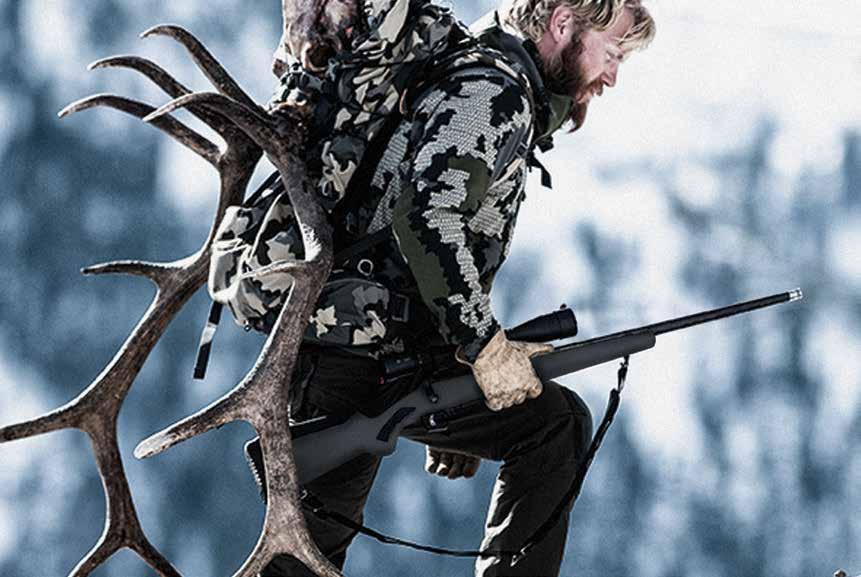
ACCURATE / driven / TRUSTED
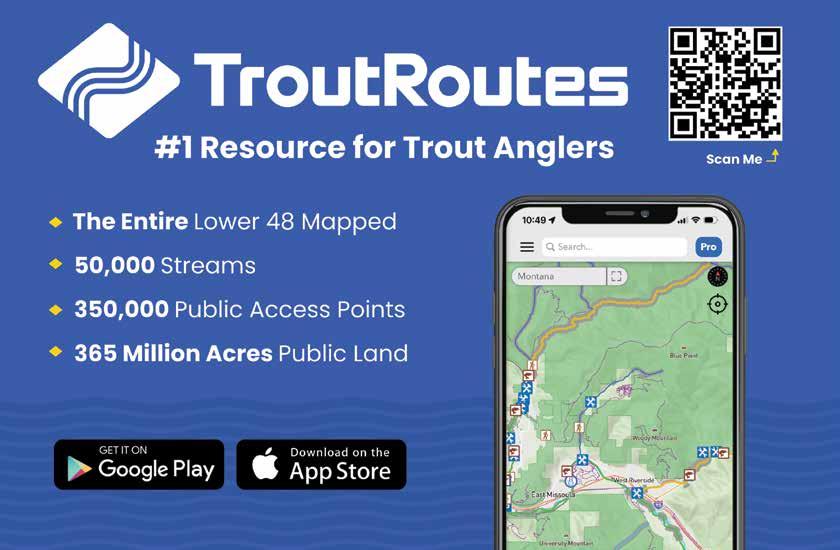
 BY MICHAEL ENGELHARD
BY MICHAEL ENGELHARD
Critics knock falconry as a cruel, passé blood sport. Proponents see a vibrant extension of medieval traditions. For Randall Compton in Fairbanks, Alaska, it’s “an expensive form of birdwatching,” the chance to witness up-close what few ever will, a privilege and a lifestyle, really. The bearded, white-haired master falconer got his first bird, Guinevere, in 1969 and flew that redtail, an allaround, forgiving, beginner’s hawk, at Illinois’ pheasants. Turning a barbecue glove into a gauntlet, the frugal teen devoured English falconry manuals, largely learning through the illustrations.


We’ve claimed a picnic table under a pavilion at the Creamer’s Field Migratory Waterfowl Refuge. Paul Stitt, treasurer of the Alaska Falconers Association of 60-odd members, with Compton discusses falconers’ darlings and techniques. Compton likes Harris hawks, which hunt in packs, for their staid nature and canine smarts. Alas, frostbite hurts the talons of this southwestern desert bird, so it’s a poor choice in Alaska, where people put theirs under 100-watt lights in January, triggering molts early enough for the Septemberto-October hunt.
With his drum belly and a faint scar bridging a boxer nose below a reversed ball cap, Compton projects iron poise. On his clad fist on the table rests Tinker Bell, a 5-year-old peregrine the size of a cat yet weighing one-fifth of one. He addresses her as “Toots” in a voice surprisingly mellow for someone of his girth. She was rescued sick
by the roadside, and he’ll soon loose her at pigeons, or at mallards or pintails, flushed from a Creamer’s Field pond, his “special fishing hole … in the middle of town.”
Falcons are lifted from cliff shelves as fuzzy hatchlings (“eyasses”) – sometimes the runts that otherwise wouldn’t survive – or trapped during their first trip from Alaska’s Arctic tundra to Chilean grasslands. According to Compton, “You’re doing those falcons a favor.” Though wild ones can live two decades, up to two thirds indeed die in their first year. They starve, freeze, drown or topple off bridges or into smokestacks. Immature peregrines crash into buildings and power lines. They’re shot, illegally, eaten by eagles or foxes, maimed by struggling prey, struck by lightning or planes – or by cars while scavenging roadkill.
Compton has removed Tinker Bell’s leather hood, and she shivers and wails, anticipating a snack.
Hooding calms and prepares the winged missile. The exbodybuilder will tone flight muscles for the famed 200-mph “stoop” dive by having her clamp meat dangling from a drone at “700, hell, 1,000, feet.” Falcons enjoy this, believing they’re robbing a rival. I’m close enough to admire the finely shaped nostrils with which Toots breathes at high speeds and the beak serration for snipping a victim’s spine.
Compton fists a dead quail, one of dozens ordered in bulk, after twisting its head off. Tinker Bell pins the carcass with one yellow reptilian foot, mantles it briefly, wings arched possessively
and, crunching twiggy bones, proceeds to devour it piecemeal. Feathers blow through the pavilion. A few stick to the short neck of the master’s Mickey’s bottle. In a grand finishing flourish, Toots with her meat hook yanks out the gizzard and flings it onto the tabletop. Bird-of-prey dining is not for the squeamish. But it’s rare to encounter such laser-beam focus, hunger so primal, bodies so fully inhabited. Handouts bind saurian to human once she’ll be unleashed, with the link snapped as quickly as overstretched rubber. If they’re sated, sidetracked or keen to migrate, falcons will ignore the glove that provides. For Dave Lorring, a retired Fairbanks wildlife trooper who has hunted with longwings since the age of 12, “A successful day of falconing is when you come back with the same number of falcons as you left with.”
Crop filled, Tinker Bell fluffs and shakes her coat, bill to obsidian toenails, announcing contentment with a kek-kek-kek less fierce than expected. Her dark-mahogany eyes, bundling light more efficiently than ours, from a mile can track three moving targets at once, equivalent to a fullback spotting touchdowns 17 ball fields away. Compton’s own eyes, with hazel irises, will soon undergo cataract surgery, an irony for a falconer.
I next meet Tinker Bell for a walk in the park. She’s being “manned,” conveyed on a novice’s arm through a Creamer’s Field clearing to become acquainted and balanced. Compton recalls no women flying falcons in his youth, quipping how “Mary, Queen of Scots must have been the last.” Men still dominate the sport, so it’s refreshing that one of Compton’s four students is female, Jesica Lawson, 40, a mother of six, self-styled bird nut and military brat. Graduating to falconry’s “general” rank can take years. State
regulations prescribe which and how many raptors one can own and the requisite setup.
For two weeks, Lawson has been nudging Tinker Bell toward flight on a leash. The object of her fascination rouses, becoming a shaking, rustling feather duster, thereby sleeking her plumage.
Lawson’s hours with Tinker Bell have been profound, a partial rewilding. “A little of the bird’s attitude rubs off on anyone who flies a hawk for a while, be it a gyrfalcon or a redtail,” writes Steven Bodio, the tribe’s New Mexico scribe in his classic A Rage for Falcons.

Wide-eyed, breathless and clearly infatuated, the blonde in jeans, owlish glasses and flowered ditch boots speaks of trust bonding handler and bird. “I’ll probably cry the first time she returns to my fist.”
Compton, on the other hand, stresses a bird’s responses to gestures, whistling, body positioning or commands hitched to food. For a joke golden eagle photo he once held up his infant son like a rabbit. Yet he distracts kids before beheading quail.
Dog-lovers strolling on the meadow’s trail repeat the same questions: “What kind is it?” “Are you going to let it go?” But thankfully not the silly, insulting, “Is that thing real?” Raptors enrapture, “seizing by force,” as the root of both words reminds us. You can’t fly them without onlookers gathering. Or even walk, apparently. Compton enlightens bystanders opportunistically.
Raptors for many people symbolize freedom and majesty. But who’s shaping whom? Who bends to whose will? For falconers, “It is not the man who trains the bird, but the bird which trains the man.” They mind their birds’ weight, obsessively, more than their own. They foot vet bills, work night jobs, watch TV or nap
“A little of the bird’s attitude rubs off on anyone who flies a hawk for a while, be it a gyrfalcon or a redtail.”
-Steven Bodio
together, trick out rigs with Astroturf and fittings and build home aviary “mews.” In season, they’re out hunting, rain or shine, daily, neglecting their children and their spouses; truly zealous falconers settle where there’s game and a job.
Nonbirders may be unaware also that breeders helped in saving North America’s peregrine, endangered by the mid-1960s by DDT thinning eggshells. California condors, prairie falcons and aplomados similarly recovered. Nowadays, pest abatement raptors chase crows raiding orchards and vineyards or scatter birds that could smash into jets. (The DOT rejected Compton’s proposal for a Fairbanks airport golden-eagle patrol.)
Back at the pavilion, Lawson offers Toots chicken tidbits, on a thumbnail, because, Compton says, “Some birds will take your finger off.” Lawson drops a morsel, and Toots ee-chups impatiently, twice: “Pick-it-up!”
Time for Toots to hop into the Hawkmobile. Transferring her to her traveling roost demands finesse. Hooded again, she steps on herself, flapping nervously, risking broken primaries. Part of Lawson’s challenge is to be deft with one hand, her other supporting the falcon. Proving mastery, Compton single-handedly ties a bowline knot, grounding Tinker Bell on her perch in the camper.
As Randall Compton regains sight, Bennett Wong prepares Chimkee, a cadet-gray 4-year-old gyr with boldly flecked underparts that reasons “as much as a falcon can,” to hunt geese before those head south. When I first saw Chimkee, carried by Wong, he was pushing a buggy, a black bear-size Newfoundland in tow. He now clips Chimkee to a 50-yard “creance” safety line.
“Are you gonna fly it like a kite?” an observing boy asks.
“No, we’re just training her,” Wong replies.
The kid turns to his mom: “He’s gonna fly it like a kite!”
After I unhood Chimkee, and Wong’s whistle shrills, she leaps off the short utility post, strokes low across the lawn toward him, twofoot sickle wings soughing, climbs, loops back, dives, stalls briefly like a dragon torching a city, and then nails the quail parts twirled on a cord.
We chill afterwards in a northwesterly breeze at the split-rail fence near a pond where Wong lets his bird survey her future hunting grounds. She thrives in such weather, all eyes, head-bobbing excitedly. Our conversation, like a skipped stone, touches on ethics, respect, the environment – as it will when considering wildlife.
Wong, who was born in Malaysia and came to the U.S. as a toddler and once owned a baby yak, says certain falconers care genuinely for their birds and the species. Others merely regard them as tools. “Might as well use a gun,” he says, which is much more efficient. He’s hunted with a “cast” of peregrines, perhaps the country’s only falconer having done so, twins he took from an eyrie near Salcha; one absconded with a tracking device worth hundreds of dollars. Tandem flying his falcons was tricky, because, “They would have liked to eat each other.”
Unlike flexible, skyscraper-dwelling peregrines, highly localized gyrs soon could be struggling. Rain alternating with freezes kills rock ptarmigan, a climate-change sentinel and breeding gyrfalcon staple. With global heating, advancing diseases and parasites will afflict gyrs – already, avian cholera grips the Bering Strait’s St. Lawrence Island. Birch, alder and more aggressive peregrines will encroach on the gyrfalcons. South-facing nests will be sweltering,

and spring storms doom additional clutches.
Beholding the duck pond and backdrop of glowing fall vegetation, Wong, a Compton alumnus with a master’s degree in biology and the director of Creamer’s Field’s Camp Habitat for youths, marvels at how many Alaskan falconers deny the climate emergency, despite being self-professed preservationists and witnessing dire new circumstances.

It’s showtime, the culmination of months-long patience and toil before the brink of free flight, for Bodio “the single scariest moment” with adolescent birds. Wong doesn’t toss Chimkee; Chimkee unfurls when she’s ready, always into the wind, encouraged by Wong raising her with his arm as if to broaden her view.
Swish, swish, swish …
She scopes out the pond first but, alas, all wildfowl have departed – the forecast calls for flurries. Ascending, she then sails the hayfield’s far edge. Wong, worried about visitor dogs, whisks the lure around, a rod baited with quail wings and breast meat. Reeling in his partner this way requires dexterity. A sloppy style can cripple an inbound bird. Chimkee, heeding the whistle, deciding the beakful in the craw beats the feast of her mind’s search image, boomerangs in, a scrap of the overcast hurtling down. The main point of refining her, at least for Wong, was never the kill. It’s the display of aerobatic flair, and above that, connection with an alien life form.
Still, such live-wire pursuits flood any spectator with awe and adrenaline.
Unsure of their birds’ loyalty and aware how fast raptors can die, wise falconers practice non-attachment. Brass ankle bells formerly signaled their birds’ doings and whereabouts. Between those tinkling relics and recent telemetry beeps, the sport’s mystique bridges three millennia. In an earlier age, they might have ridden in Genghis Khan’s retinue, escorting a falcon primed for herons and stoats. Or they would have worshipped Freyja, who shapeshifted donning a falcon-plume cape, or peregrine-headed Horus, the sky god whose glyph was the eye. As it stands, Compton lives where the “grand species of birds for falconry” live, “fooling around with an addiction” yet, he insists, not fully consumed.
Michael Engelhard is the author of Ice Bear: The Cultural History of an Arctic Icon. He worked for over 20 years as a wilderness guide in the Desert Southwest and Alaska.






Steeped in tradition, built to perform. With comfort, traction and durability that stand up to the hunt, the new Recurve boot is made for swift, confident movement through tough terrain. DANNER.COM/RECURVE

M ulti-piece trout rods that perform like one-piece rods, the new Trout Pack Series features handcrafted St. Croix quality and proven performance in two highly packable three-piece designs to support elevated o -grid angling adventures.


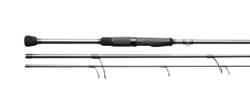
Offer Rich Paini a handful of nuts and he’ll accept. He’ll get one or two in his mouth before the rest fall through his hand. He’s missing his left ring finger so when he makes a fist there’s a hole.
“It’s really ridiculous,” he says. “It’s 11 years later, and I’ll be like, ‘Oh cashews,’ then bonk. They start falling out.”
Paini was bowhunting elk in Island Park, Idaho, in September 2011. He walked silently through a corridor of tall willows. A large, dark grizzly bear was in the same corridor for the same thing, elk, but Paini didn’t know that until the bear tackled him.
“I heard just an enormous crash,” remembers Paini, co-owner of Trouthunter. “The bear had me by this arm (right), which it ultimately broke, and I had my wooden recurve in this hand (left) with arrows in a quiver. It bit into my bow, through all those arrows.”
He recalls the attack in slow motion, but it happened in an instant. It was a warning bite. The bear, chomping more arrow than anything else, ran away leaving Paini broken and bleeding. Metal plates puzzled his body parts back together. He does everything he’s always done, including rowing, fly fishing and hunting, but he never returns to that willow corridor.
“The truth of the matter is, I’m sure I could go out there a million times and never see a bear again, but I don’t go back there,” Paini says. “There’s something visceral to that area. I think I’ll leave it alone for now.”
Despite his missing digit and his aversion to walking through willows, he doesn’t want to do away with grizzlies. He survived the attack and so did the grizzly. They both live in the Greater Yellowstone Ecosystem.
“It’s human nature to think we’re the top of the food chain. We’re it.
But here we’re not,” Paini says. “I think it’s an honor in the sense that these apex predators share space with us.”
Not everyone feels honored, especially if their livelihoods are at risk because a deadly animal is expanding its presence across the West.
“I can’t say I’ve lost a lot of cattle to grizzlies bears, but I have lost three or four up on this permit over the last few years,” says John Crumley, Madison Valley Ranchlands Group president, while turning out cows on a public land grazing allotment in Montana’s BeaverheadDeerlodge National Forest. “You cuss, and you wish you could get rid of the grizzly bear.”
That almost happened a century ago. Grizzlies were killed for two reasons: sport and protection. We thought prey needed our protection so we hunted predators for sport nearly to extinction, but grizzlies hung on in Yellowstone National Park. They were welcome in the park for two purposes: eating and entertaining. Bears entertained us by eating our garbage. Open pit dumps with names like “Lunch Counter” were an all-you-can-eat buffet with benches. The buffet was for bears. The benches were for tourists watching grizzlies eat garbage.
“Quickly visitors started flocking to these dumps,” says Alicia Murphy, Yellowstone National Park historian. “It was the most popular activity in Yellowstone for a long time.”
When the dumps closed in the 1970s, the grizzly population plummeted. Grizzlies had three choices: starve and die, get in trouble and die or learn to be wild and live. Many died. Grizzlies were listed as threatened under the Endangered Species Act in 1975. The GYE population shrunk to less than 200 by the 1980s. Seeing a grizzly was unheard of. The few hundred that hung on stayed away from the people who didn’t feed them anymore. They found natural things to eat instead and the population started recovering. Grizzly No. 399 of Grand Teton National Park in Wyoming, probably the most

photographed grizzly in the world, proved recovery true when she started parading cubs close to roads in the early 2000s.
Today, the GYE hosts more than 1,000 grizzlies. The population is considered recovered, but grizzlies are still on the list. They’ve been delisted twice, in 2007 and 2017. They’ve been relisted twice, in 2009 and 2018. U.S Fish and Wildlife Service is reviewing their listing status again this year.
The three states included in the GYE – Idaho, Montana and Wyoming – want grizzlies delisted. If bears lose federal protection, states would be in charge. Hunts could happen. When people disagree on the future of grizzlies in the GYE, they’re not arguing over listing. They’re fighting about hunting.

“Oh, they should be delisted and managed,” Crumley says. “If it means killing them and reducing their numbers then they’re going to have to do that.”
“Absolutely stay on the list,” counters Kristin Combs, Wyoming Wildlife Advocates executive director. “There’s another way to do things. You can still have livestock. Grizzlies can still roam the landscape. To kill something that majestic, and something the Tribes have a spiritual connection with, is just wrong.”
According to the Eastern Shoshone in Wyoming, one of several dozen Tribes claiming the GYE as their native land, grizzlies are a sacred being. They’re a symbol of strength and courage. They’re also considered their brothers, but hunting isn’t out of the question.
“They have a spirit just like we, and any time we take an animal we give them respect,” says Nathaniel Barney, Eastern Shoshone cultural and spiritual representative. “I think our sportsmen today are more respectful to what they’re killing. I believe they have a
very good opportunity to help protect the species by limiting the amount.”
If grizzlies are delisted again and hunts are on the table again, limits will be vital. The last thing any state wants is a delisted species put back on the list because of population decline on their watch.
“Whether the bears are ever delisted or stay listed or whatever, our goal is to maintain them where they are at right now,” says Jeremy Nicholson, Idaho Department of Fish and Game wildlife biologist. “They have a lot of people that are concerned about them that are not going to let them plummet.”
As for Paini, he still hunts elk with a bow, and he still hunts the unit where he was attacked, but he doesn’t hunt those willows, and he doesn’t want to hunt grizzlies if that’s ever allowed.
“Maybe I’ll go to my death letting them be up one to zero on me,” he says.
As for Paini’s missing finger, it was found. It was returned after DNA testing during the attack investigation. You want to see it? Ask his wife Millie. She wears his finger bone, with wedding ring attached, as a necklace.
Outdoor journalist Kris Millgate is based in Idaho where she hunts birds, runs trail and chases trout. Sometimes she even catches them when she doesn’t have a camera, or a kid, on her back. My Place Among Fish, the sequel to her first book, My Place Among Men, is available now. She followed salmon migration solo during the pandemic for the Emmy-nominated film Ocean to Idaho, and her new film, On Grizzly Ground, premieres in August with her third book My Place Among Beasts. See her work at tightlinemedia.com.
Trouthunter co-owner Rich Paini was attacked by a grizzly bear while bowhunting for elk in September 2011. The bear broke Paini’s right arm and bit off his left ring finger.TITANIUM

CARBON FIBER TENSIONED

THREADED BOLT KNOB









Canada’s Inuit (formerly called Eskimos) migrated from Asia thousands of years ago and settled the Arctic, a settlement that predates the prehistory of the First Nations people “North of Sixty.” North of Sixty refers to the 60th parallel, a latitude that separates the Northwest Territories, Nunavut and Yukon territories from Canadian provinces. Aboriginal life must have been a never-ending struggle while living off the land because of the long, cold and often brutal winters and vagaries in the seasonal distribution of game. Clothing, food, medicine, religion, shelter, transportation and water were essential elements of survival. To this day, some Inuit still live largely a subsistence lifestyle, hunting and fishing.
On April 1, 1999, Canada’s former Northwest Territories was divided into two territories to allow for the creation of Nunavut, a homeland for Canada’s Inuit. Nunavut is situated in the eastern Arctic where the barren grounds stand as a testament to the harsh environment.
According to Statistics Canada, the Nunavut population in 2022 was estimated to be only 39,589. The territory covers an area of 787,155 sq. mi. (2,038,722 sq. km.) the largest of all provinces and territories in Canada, about three times the size of Texas. Nunavut comprises a major portion of northern Canada and most of the Canadian Arctic Archipelago. By and large, it remains a vast, uninhabited wilderness.
The Inuit name for the short span of the Ekaluk River that flows west from Tahiryuaq Lake (aka Ferguson Lake) into eastern Wellington Bay is Iqualuktuuq. (The word Inuinnaqtun, meaning “place of big fish” is also associated with this area.) It’s an important archaeological area and has been inhabited for the last 4,000 years by Tuniit (Dorset culture, pre-Inuit) and later by Inuit peoples. Historically, the Iqaluktuuq has been a key area for char fishing and caribou hunting for local Inuit who are called Iqaluktuurmiut. And it was the char that would bring me to this faraway land.
After a long-standing romance with the storied history of the Canadian Arctic, one of my dreams was to fly angle for Arctic char (Salvelinus alpinus). Salvelinus is a genus of salmonid fish often called char (or charr); alpinus means “of the mountains” and dates back to the species being given a scientific name from northern Europe by the father of taxonomy, Linnaeus, in 1758. My quest took me twice to the renowned Tree River, Nunavut, and eventually on a DIY trip of a lifetime to B&J Fly-fishing Adventures fly-in camp beside the Ekaluk (also spelled “Ekalluk”) River, on Victoria Island, Nunavut. This unique, wilderness camp was owned by Bill and Jessie Lyall, who are Inuit from Cambridge Bay, Nunavut. The Lyalls said it was never really meant to be a business operation in the usual sense. Rather, it was intended to provide guests with a unique Arctic experience.
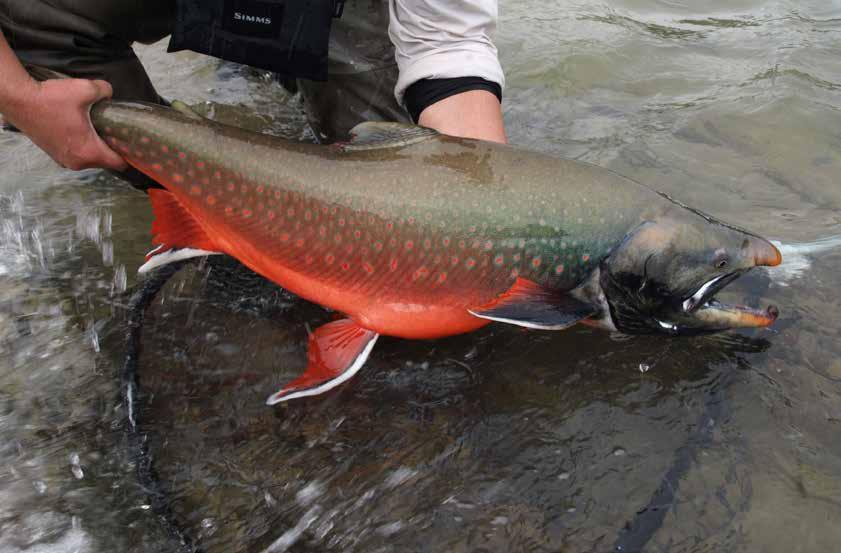
The International Game Fish Association Arctic char world record is a 32-pound 9-ounce fish caught by Jeffery Ward in the Tree River in 1981. Jack Elofsson, who managed the B&J Flyfishing Adventures camp at the time of my trip was adamant that an Ekaluk River char would some day top the Tree River record; he may be right because in 2012 two char, gutted and gilled, caught in commercial fishing nets in Ferguson Lake, weighed 32 pounds.
The color of Arctic char is extremely variable, hinging partly on the size of fish and their habitat and depending on whether they’re sea-run fish, taken during their spawning season in fresh water, and also between sexes. Usually, fresh sea-run char will have a darkcoloured back with silverish sides and a white belly, with white leading edges on their fins. These telltale white edges are clues as to their whereabouts when sight casting to char in fresh water. Sometimes, their sides and backs are covered with violet-pink or reddish spots. When spawning, char often take on a striking red or orange color.
The best time to catch char is in late August when fresh fish run upstream to spawn. The numbers and timing of char coming inland from the sea varies.

I flew with First Air, left Edmonton, Alberta, at 7:30 am and was fishing on the Ekaluk River in the early afternoon of the same day. Bill Lyall’s daughter Fiona met me at the airport and took me to a nearby float plane base where Fred Hamilton ferried me in a de Haviland Beaver to the Ekaluk River.
I would have been ill prepared for my adventure on the Ekaluk River had I not previously fly fished for char on the Tree River. This river is as iconic to char aficionados in Canada’s fly-fishing circles as the Mounties or Calgary Stampede are to the nation’s international tourism scene. It’s one of the most challenging rivers I’ve ever fished and is not for sissies. It was a humbling experience, but I learned
some valuable lessons on fly angling for char that would pay dividends during a subsequent trip that later carried forward on the Ekaluk River. The first time I ventured to the Tree River was on a three-day fly out from Plummer’s Arctic Lodge on Great Bear Lake. I took my first ever char from “Slippery Jack’s Pool” a brute that taped 35.5 inches – not bad for starters.
After it plunges over the thundering Tree River falls, the river cascades over rock ledges and through myriad boulder gardens, chutes and rapids on its way to Coronation Gulf. The turbocharged river is dangerous – the foolhardy only a step away from death by drowning. My second trip to the Tree River was with my son, Myles, a weeklong excursion where our sole focus was on catching char.
After two trips to the Tree, I figured out the ropes to fly angle for char: proper fly angling gear, go-to flies, Atlantic salmon casting techniques and how to find promising holding water. Myles and I had a stellar trip, landing dozens of char up to 36 inches, so when I ventured to Camp Ekaluk I was confident in a DIY trip without being guided. My trips to the Tree River steeled me for the Ekaluk River’s challenges.
Bill Lyall and Jack Elofsson told me from the outset that Camp Ekaluk was a wilderness camp. “Don’t expect anybody to babysit you; you’re on your own,” they said. Guide services were not provided. Guests should be prepared for rustic, but comfortable, accommodations and home-cooked meals. Their goal was to provide clients with a unique northern experience when it comes to cuisine. I feasted on char sashimi and chowder, baked char, Cajun char, muskoxen loin, caribou and muskoxen roasts and bannock. The unique culinary experience was one of the trip’s highlights.
We had 35 knots gale force winds, pelting rain, fog, overcast skies, only a little sunshine. Snow is not unheard of. I was in bed at 9 p.m. and up at 6 a.m. daily.
Expect to see muskoxen. Keep your eyes peeled for barren ground grizzly bears, which crossed over from the mainland on sea ice about
35 years ago. Upon my arrival, Bill said there was a resident sow with two cubs a few miles outside of camp but that they wouldn’t likely venture near the Ekaluk River. To my surprise, I found fresh grizzly tracks the next day a few miles from camp. I’d suggest you take bear spray and bear bangers (which I did pack) as a precaution.

I’ve fly-fished for all of Canada’s salmonids and can say unequivocally that fresh Arctic char are very challenging to land with a fly rod. They have tremendous acceleration and can strip 100-200 feet of line in mere seconds. They’re virtually unstoppable when they run downstream. If you don’t chase them, they’re gone! The stakes are high, but that’s why fishing for Arctic char is at the pinnacle of outdoor adventures for fly anglers.

Tree River fishing guides favor either unobtrusive fly patterns for char such as the Blue and Pink Rat wet flies or the gaudy Pixie’s Revenge. On the Ekaluk River, camp staff recommended pink and chartreuse streamers. I preferred natural patterns that imitated slimy sculpins on the Tree River, but I ran the gamut of extensive patterns in my fly box. Fresh fish are easier to catch, while fish that have been in the river a while can become more difficult. A general rule of thumb is 8- to 10-weight rods with heavy 12- to 15-foot sinktips and large streamers or Spey flies. Productive patterns include Zonkers, Clouser Minnows, Lefty’s Deceivers, Mickey Finns, Spey flies and Popsicles.
You’ll see lots of char in quiet water near the bank of the Ekaluk River and can sight cast to them; they’re wary, and if they spot you, they’ll dart into deeper, swift water. The char fishing was outstanding. My largest fish taped 36 inches, and while I had to work for them, on a good day my catches were in the double digits, almost unheard of in other camps. Yes, the Ekaluk River is fully deserving of its reputation as one of the world’s top char fisheries!
Jack Elofsson said, “This place is Holy!” On the fourth day of my adventure (a Sunday), I experienced one of those life moments I’ll never forget when I hiked to the rapids below Ferguson Lake and fly fished the “Upper 2000” and “Lower 2000” beats without another person in sight. I landed 10 char up to 36 inches that fine day and lost more because they’re that hard to beach in the swift river. Yes, I was truly blessed.
BHA member Duane Radford is a multiple award-winning writer and photographer; he’s written 1000+ magazine and newspaper articles, fish and wild game recipes, plus 10 books.



































































































“For the animal shall not be measured by man. In a world older and more complete than ours, they move finished and complete, gifted with the extension of the senses we have lost or never attained, living by voices we shall never hear … caught with ourselves in the net of life and time, fellow prisoners of the splendour and travail of the earth.”
Beston, BY M. ROBBINS CHURCHWe left Sun Valley after work that early-August evening of 1968. It had been a turbulent year, one of savage battles in Southeast Asia and, at home, terrible losses – Martin Luther King, Bobby Kennedy, others just as dedicated but less well known.
Three other boys and I jammed ourselves into the open Jeep and headed out, away from the incessant, sad news – through the sagelands, into the mountains. We had sleeping bags, some water, candy bars, scant gear. At 20 years, I was the oldest.

We drove west out of Ketchum in the twilight, bracing ourselves against the chill of the Idaho night air. None of us dared complain of the cold. We all knew we could have been – and could yet come to be – humping the hot and deadly landscape of Vietnam, writing grim letters home to worried parents and disheartened girlfriends. Instead, we were here this night – an ocean, a world away.
Our mission for this trip was simple: we wanted to get away and see some country. I had stashed a fly rod, hoping to catch a trout in a mountain lake.
The road west of Ketchum was empty. Save for a few lights in
windows of scattered ranch houses, we had the Idaho night to ourselves. We paused at the pullout on the west slope of Galena Summit to view the Salmon River beyond. A full moon was rising, flooding the valley of The River of No Return with silver, a scene even the most callow young men couldn’t ignore. We shared few words before climbing back into the Jeep and heading on.
Down the mountain and into the valley we rode, in the shadows of the Sawtooths, then downstream close beside the Salmon – the moonlight dancing off its rapids and pools, reflected in its graceful meanders.
A dozen miles past Stanley, we turned onto Yankee Fork Road. One of my companions, our driver and guide to the lake, said, “You know, there is an old gold dredge up here; wait until you see this thing.”
I did not know what a gold dredge was. I would soon find out. A few miles up the road it appeared – ghostlike in the cold moonlight. We crunched to a halt in the dirt and gravel.
There it sat, a metallic structure, some four stories tall, with long cabled appendages fore and aft – a hybrid thing, half building, half machine. Once self-propelled, it was now dead weight, abandoned














and immobile, settled in silence in its own waste. Around it, for several miles along the stream, lay its legacy of barren rock and gravel, mounds of its dredge tailings that had transformed the valley bottom into a moonscape. Yankee Fork, in which it once had churned and gobbled in its pursuit of gold, had been shunted aside, reduced to a rubble-lined ditch.

We dismounted our cramped Jeep and stretched. I grabbed a flashlight and walked over to the sad sluice of a stream. I turned my torch on the water, and in its circle of light, close to the bank, appeared a single Chinook salmon –a wild fish, a hen. She held there for a moment, her body undulating in the flow, then swam out of my light, headed upstream.
As we drove away, I recalled the Chinook I had seen the night before. I have no photo of that fish, but I carry with me, seared into memory, a perfect image of her – one that remains forever in unfading focus.
Like that fish, we four young men were but sojourners. In a month, we would disperse, never to see or hear from one another again. We had few timelines and obligations, no purposes yet in life. Barring the war, we were free to make of life what we might.
Like that fish, we four young men were but sojourners. In a month, we would disperse, never to see or hear from one another again. We had few timelines and obligations, no purposes yet in life. Barring the war, we were free to make of life what we might.
We climbed back into the Jeep and moved on through the spectral landscape. Up the valley we went, over a ridge, at last arriving at the creek that drained from the lake we sought, high up the mountain. There was no campsite, no “facilities,” just hard ground. We found spots between rocks and roots and threw down our sleeping bags. I awoke in the night to a field mouse scampering up the length of my bag, exploring my upturned cowboy hat, then retracing its path and vanishing into the shadows of the night. It seemed the full moon had brought wanderlust not only to men, but also to mice. I wished it well and drifted back to sleep.
The next day, we climbed game trails to a crystalline lake. In bright sunshine, I spied a single, small golden trout, a gleaming, vermillion-slashed cruiser I enticed with my fly placed in its path. I landed it and returned it quickly to the lake. It was the first and, likely, only golden trout of my life, documented by a hurried, blurry photo.
That afternoon, we made our way back down the mountain through the green lodgepole forest, then along the undisturbed upper reaches of Yankee Fork. We came upon the residue of the dredge well before we saw the thing itself. It looked like war had come to Yankee Fork and that the stream had lost every battle. We paused at the dredge, trying to fathom what manner of beast had caused this, then rode on, wondering if the damage it had done could someday, somehow be undone.
Unlike us, the fish of Yankee Fork had no such options. She had struggled for survival since the day she swam up out of the gravel, facing new challenges and dangers at every turn, on every journey. Now she was almost home, but with still one place more to go and a mission yet to fulfill. Through the stark scape she traveled that night, pushing on, seeking a better place, a sinuous, protected place – one with the cover, currents and gravels she needed – a place to close the loop of her life.
I think of that fish often, of her innate tenacity, coded into her being by uncountable generations of bold, insistent ancestors. I hope she succeeded in her quest. I hope she made it home and brought new life to her stream. And I hope her descendants still find their way up Yankee Fork — casting shadows under the full moons of August.
BHA member Robbins Church, Ph.D., came west from Virginia to Idaho in the summer of 1967 to fish Silver Creek. He returned two more summers, guiding in 1969. He was an initial employee (1970) of the U.S. EPA and spent the last 30 years of his research career with that agency. He holds degrees in chemistry and aquatic ecology from the University of Virginia.
Editor’s Note: The Yankee Fork historically supported robust populations of salmon, steelhead and trout, but mining – and the intensive timber harvest that accompanied it – reduced what once was a complex, meandering river into a virtual flume. More from our conservation partner Trout Unlimiated at tu.org/magazine/ conservation/reflecting-on-the-yankee-fork-project/

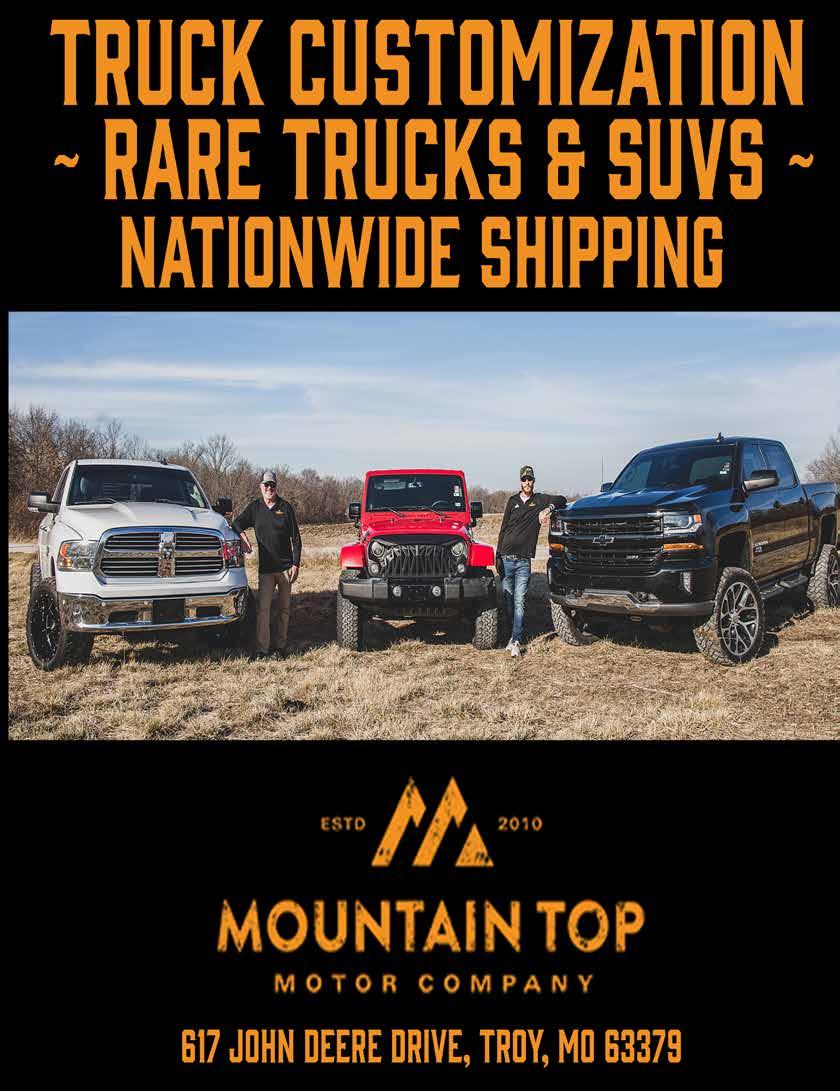
NO MATTER WHAT THE SEASON.

NO MATTER WHAT THE TERRAIN. GO WHERE OTHERS CAN’T.™
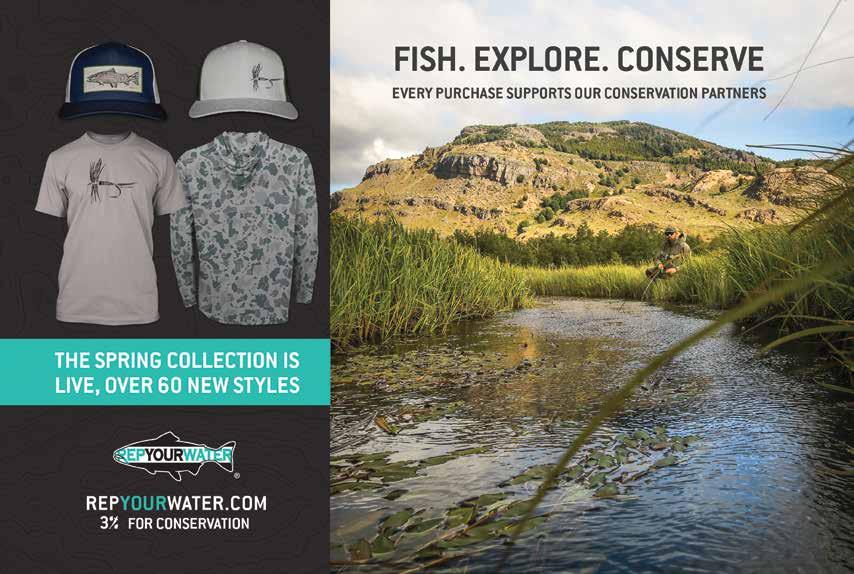
I slide my kayak down the beach and into tranquil ocean waters and am overcome with the same feeling as waking up in September to an ear-piercing elk bugle. Practice, preparations and civilization are left somewhere in the past; my focus is only on the present.
Kayaking the ocean is a unique wilderness experience. Moving quietly and slowly puts you face to face with subtle details that will make you a more knowledgeable sea angler. Your kayak moves with the slightest shift in current. Dead silence is broken by the breath of a passing sea lion, porpoise, or whale. That same silence allows you to enter fishing grounds undetected.
And when you connect with a fish, it’s just the two of you out there – a-one-on-one test of physical strength.
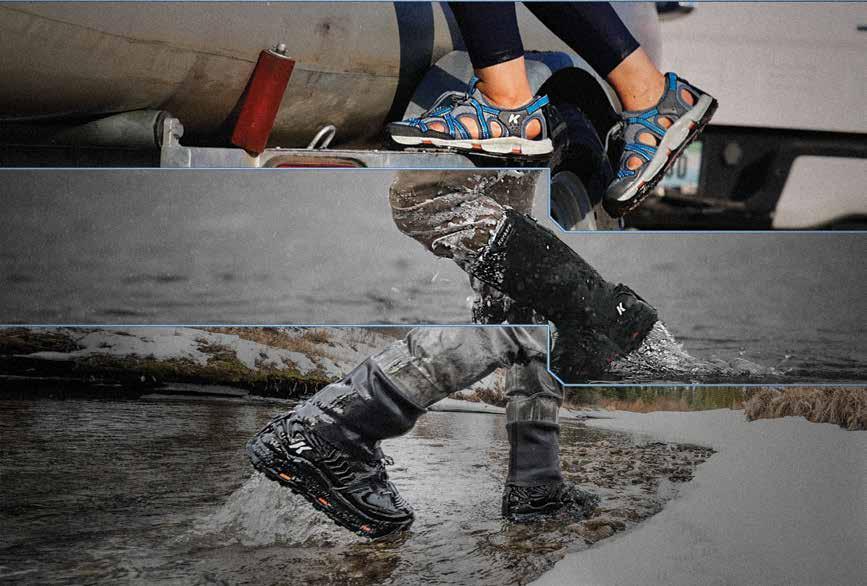
It was more than a decade ago when my brother and I first ventured into the ocean on a tandem rental kayak. Five years later and I had deck handed on a charter boat in Alaska and spent dozens of days kayak fishing in every state on the West Coast – our inaugural kayaking trip had turned into an obsession. After years of staying inshore to fish for lingcod and rockfish, I was ready for a challenge.
Three years ago, a calm ocean forecast lured me to the Washington coast on a hot June weekend. I had one thing on my mind: “barn door” Pacific halibut. Greeted by a placid ocean and cool, dense fog, having battened down my gear, I punched my kayak through small

breaking waves and headed three miles out, straight west into the open Pacific Ocean.
When I arrived at the area I wanted to fish, 200 feet deep with a strong tidal current – about three miles per hour – the shoreline had long disappeared in a thick bank of fog. When you’re miles out and you can’t see or hear shore, it can be downright eerie – and impossible to tell which direction is which.
But in recent years I have learned to cherish the fog. Its presence usually means no wind, and no wind means no wind waves. With dead silence and no distinguishable horizon, the experience is as close as it gets to floating on a cloud. I use my GPS to navigate, and I always bring a backup compass.
I sent my bait down to the bottom, and a few minutes later my rod bent over so far that the tip was underwater. Right away I knew it was a good-sized halibut.
Line ripped from my reel so quickly that although the fish was 180 feet down, my line was almost horizontal because the fish was so far away. I pedaled my kayak as fast as I could and eventually positioned myself straight above the fish. After tightening the drag, I slowly lifted my rod upwards, reeling as I let it back down. But every time I made progress, the fish took off, back to the bottom. I was exhausted and the current was pushing me onward.
Glancing at the GPS, I was already two miles from where I hooked the fish. This is when I noticed I was moving directly toward a rocky point with breaking waves.
As I brought the fish closer to the surface, I prepared my halibut harpoon – a wood shaft with a sharp metal tip that pierces through the fish and toggles to create a “T” on the other side. That tip is attached to a big orange buoy. (A lot of powerboats use a harpoon, but many prefer the simplicity of a shotgun.)
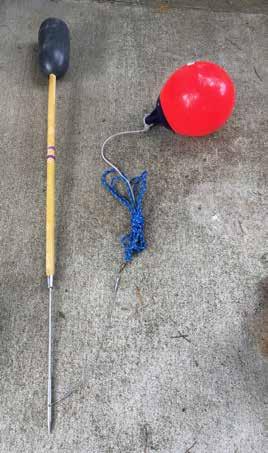
When I finally had the halibut next to my kayak, I couldn’t help but be reminded of The Old Man and the Sea. My heart pounded like I was drawing back my bow on an unsuspecting deer. I tossed my harpoon buoy into the water behind me and made sure the rope was free from myself and my kayak. With my left hand holding my fishing rod and my right hand holding my harpoon, I lifted the fish toward the surface and sent the harpoon home.
I felt like the kid at the trout pond watching their red and white bobber go down. That big orange buoy shot under the surface, and line screamed from my reel until I saw the buoy pop up several hundred feet away. I reeled the fish in one last time and was finally able to dispatch it with a bat and bleed its gills. Landing the fish went as smoothly as possible, but the whole thing felt very barbaric.
By this time, I had drifted far too close to breaking waves. Instead of trying to get the fish onto my kayak, I had to drag it next to me in the water for a mile to create space between myself and the dangerous wave break.
Lifting the fish onto my kayak was a struggle, but after a few unsuccessful attempts at putting it behind me, I was able to get it up on the middle of my kayak underneath my legs. By the time it was secured, I was close to the breaking waves again; tidal current is the real deal on a kayak.
After four miles of goofy pedaling with a giant halibut beneath me, I was back on shore. With an uncontrollable smile, I dragged my kayak up the beach back toward my campsite. A woman strolling down the beach asked, “Did you catch anything?” Before she finished her question, her eyes widened, making sense of the fish stretched across the cockpit of my kayak.
I felt like the kid at the trout pond watching their red and white bobber go down.
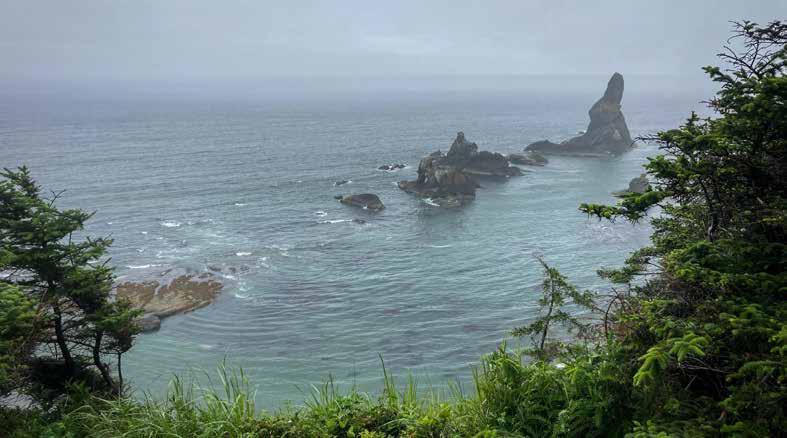
Before I could answer she made some loud exclamations and told me that she’s an avid spearfisher but had never seen such a big halibut. It was fun to share my excitement with someone who fully understood the accomplishment, and she was thrilled to take a photo for me.

Measuring 55 inches and weighing 80 pounds, it wasn’t one for the record books, but for me it was the best fishing experience of my lifetime. Since this trip, I’ve spent some long, grinding days targeting halibut, and I’ve never been so lucky. It isn’t easy from a kayak, especially in the lower 48. Halibut fishing from a kayak feels more like big game hunting than fishing – more effort, more risk, more reward – with a harpoon to seal the deal.
Kayaks allow you to utilize small, remote coves for access – far from motorized boat access. These public waters are as important to me as our public lands because they check the same boxes: abundance and diversity of wildlife, breathtaking scenery and the opportunity for anyone from the public to experience the wilderness and harvest wild food. Getting out and onto the ocean can be intimidating and expensive. Kayaks bridge the gap and make accessing public waters possible for many of us unable to commit to boat ownership.
The popularity of kayak fishing has skyrocketed since my brother and I started over 10 years ago. There is an opportunity for this burgeoning community to organize in support for nearshore fishing rights and public access along our shorelines.
Kayak fishing opportunities are abundant in every state, and it’s an intimate way to enjoy pristine wilderness with the added bonus of bringing home fresh, wild fish.
BHA member Tyler Mann is a northwest fisheries technician turned carpenter with a passion for all things hunting, fishing, gathering and cooking. He and his fiancé Olivia share their recipes, stories and tips on their blog at HuntFishHarvest.com



Any day with a fly rod in hand is a good day. But what if you could float waters few boats have access to? Wade streams few anglers have stepped in? Present flies to unsuspecting fish? Picture it.
Purpose-built for adventure anglers, Slipstream Rafts feature a streamlined design to eliminate catch points and high-pressure drop-stitch floors with EVA foam decking for stable footing whether you’re sighting, casting or netting a fish. The sleek fishing frame has an internally routed anchor system and optional rod-holder tubes, enhancing your on-the-water experience. Available in three sizes to suit your adventure needs, in a Slipstream raft you don’t have to picture it, you can fish it.
 Scan
Scan
Hanging with you BHAers has forced me to ponder a question: Why don’t I love the outdoors?
I mean, you guys love the outdoors. And I love you guys. Shouldn’t I, therefore, love the outdoors, too? Doesn’t a = c?
Apparently, the transitive property doesn’t apply here because no – I don’t love the outdoors.
Remember when Indiana Jones was River Phoenix? He was totally fine with snakes.
He stopped being fine with snakes when he landed in that reptile car on the circus train.
So, what is my circus reptile car? What is the thing that sparked my distaste for the outdoors?
I think it’s the pop-up camper. The used pop-up camper my dad bought when I was 4 years old.

I remember it parked on our patio while I helped my dad with repairs.
I mentioned I was 4, right?
“Hold this,” my dad said, handing me a thick wooden beam. “Don’t let it move.”
Now, I’m a bit scrawny and super pasty. Like that guy Brad Pitt, Morgan Freeman and the entire SWAT team think is dead in Seven.
Remember the air freshener trees hanging from the ceiling? And when he – well, I won’t spoil it. But it was almost as good as when Kimberly took off the wig on Melrose and …
Wait. Sorry. I got distracted.
The camper. Helping my dad. Right. Well, I was no more robust when I was 4 years old, holding that beam, than I am now. I looked like Gollum in Lord of the Rings.
So my dad handed pale, skinny me the beam. He picked up a hammer. And then my 6-foot, 200-pound, United States Marine Corps dad hit that beam.
Yeah. The beam moved.
Into my face.
So the pop-up camper and I did not start on a good note. We hitched the camper to our Datsun hatchback that first summer we owned it, to be our vacation home in North Carolina. When the camper fully opened, sleeping berths flanked a central “kitchen.”
I say “kitchen” because the camper had no running water. No gas. I don’t know what that sink was for, but it wasn’t for washing things.
My parents slept in the bunk to the left of the kitchen. My brother and I slept in the bunk to the right of the kitchen.
The next summer, we again lived in the camper. But now it was me, my brother and my brand-new baby sister in that right bunk.
While you do the math, I’ll reflect on my parents sticking a 3-monthold baby in a pop-up camper bunk with a toddler and preschooler and a questionable kitchen separating all of us from the adults.
I’ll also wonder how I didn’t wind up with a fourth sibling.
One night, I woke with a desperate need for the bathroom. My mom navigated me through the tents and campers to the facilities.
A throng of women and children huddled outside of that bathroom like survivors of the Titanic huddled on lifeboats in the Atlantic.
Frogs. So many frogs. A layer of them coated the bathroom’s threshold, the world’s slimiest carpet.
What did I do? Did I brave the frogs to use the facilities? My phobia of frogs would say yeah, dingus, that’s where I was born. Do you think frog phobia is a natural human condition? No! I, your frog phobia, was born the moment you crossed those frogs.
I also have a snobby contempt for outdoor bathrooms, portable or otherwise. The Bathroom of the Midnight Frogs could certainly be the origin of that.
But.
But I don’t know what I did. My brain has blocked the memory. I can’t claim the crossing-of-the-frogs theory because I also have a strong dislike for, um, going outside. Wouldn’t that dislike suggest I had done my business outside that night, to avoid the frogs?
In fact, in my life, I’ve used outdoor bathrooms more than I’ve used the outdoors as a bathroom. That was just once, between two tractor trailers, during a hurricane.
I don’t want to talk about it.
The year after the Bathroom of the Midnight Frogs, we again hitched the camper to the Datsun hatchback. This time we went to Virginia.
“Hold up,” my father-in-law said when I told him this story. “Your dad hitched a pop-up camper to a Datsun hatchback?” Said with all the incredulity of Marty McFly questioning the Delorean made into a time machine.
Yes. Yes, he did. My dad hitched a camper to a vehicle half the camper’s weight. Marines don’t really have “you can’t do that” in their vocabulary.
Did my dad know it was going to rain that heavily? Doubtful. The camper hydroplaned, spinning the Datsun like it was Peggy Fleming.
The Datsun was totaled. The camper was totaled. My relationship with the outdoors was totaled.
And that was it. That was the end of the camper. Oh, sure – my dad floated the idea of another camper. But Mom was done with Virginia rainstorms, frogs and children conceived in North Carolinian campgrounds.
We rented houses after that.
LIKE NORMAL PEOPLE.
I asked my dad about the camper last year.
“Why?” he asked. “You looking to get one?”
“Have you just met me? Because, ew. No,” I said. “I’m not a camper kind of girl,” I said.
“I know. Like your mother,” he said, not unkindly.
But not exactly happy, either.
Then my dad told me the camper did, in fact, have a bathroom.
“It was a hole in the floor,” he said.
And I waited. Waited for more of an explanation. But that was it. A hole in the floor.
Did I ever use it? You tell me, because, well, I also have an aversion to hole-in-the-floor bathrooms.
But not to you guys.
Hopefully, that’s all that matters.
BHA life member Wendi Rank is an indoors enthusiast from Pennsylvania. She spends her free time patiently waiting for her husband to return from hunting. Her writing has been published in Nursing and the Journal of Neuroscience Nursing, and she’s a columnist for American Community Journals.






I sneak onto a couple of ranches that hang game cameras along trails and wallows. One cam caught me at full draw aiming at a 6x6 muley. By the time I’d boiled the skull, the ranch manager had posted my mug to Facebook. He offered a $500 reward. You probably think I slipped up. Nah. I called my buddy at the carwash.
“Hey Vernon,” I said. “You gotta turn me in.”
“Nice,” he replied. “Same deal as before?”
“Yep, $120 goes to the fine. We split what’s left of the reward.”
Vernon bought an oak console table with his cash. He stole a Panasonic TV to sit on top. I paid off the loan for my crossbow.
After social media gave away all the good spots, I had to trespass to find solitude. Hipsters flooded the national forests and then bragged about their hunts on Instagram, basically recruiting competition. They don’t realize the true challenge is hunting private without permission. Landowners watch their boundaries like prison guards, and the rich ones have an unlimited bankroll to catch your clumsy ass. Trespassing puts the stealth back into hunting.
My largest buck came from underneath a swingset. After seeing the animal from the road, I scampered to the house with my bow, ducked the bay window, and crawled to the cover of a hydrangea. A garage door stopped the bloody arrow. (You should always have a backstop for safety.)
While dragging the deer across the lawn, I looked through the bay window. Inside, a feeble snowflake of man was helping his son doodle with crayons. My dad never helped me doodle. After his court appearance, he drifted into the woods each hunting season. He skipped out on weeknights the rest of the year.
That’s why I became a mentor.
I found my mentee, Henry, as I peddled vape pens outside the junior high. I trained him in backcountry evasion, smooth-talking, and CrossFit. He learned hunting ethics the same way my dad
taught me: by reading back issues of Buck Lust magazine. As Henry and I were driving past an alfalfa field one night, I felt like I was reliving my childhood.
“Am I doing something wrong?” Henry asked between trembling lips. I anticipated what would follow. A story of him somehow finding the hunting regulations, realizing he had committed more than a dozen trespassing violations.
“What do you mean?” I asked, deciding to hear him out.
“When you use my tag?” He stared into his lap. “Is that party hunting?”
“Henry,” I chuckled, “party hunting is when you kill an animal but celebrate too loudly.” I slowed the car to survey a band of whitetails. “If my dad taught me anything, it’s that game wardens hate boasting. So, let’s be quiet tonight.” I opened the console between the seats. “Here, take these batteries. Your spotlight’s going dim.”
Some landowners hire ex-Border Patrol to guard their boundaries. Others do it themselves with sidearms. When they confront Henry and me, I step behind the boy and set my hands on his shoulders like we’re taking a family photo. One landowner approached us in his cornfield as we recovered two Canada geese. He asked the same stupid question they all do: “You know you’re on private land?”
“Sorry sir,” I said. “We started on a state section this morning. I guess we lost track of ourselves.”
“Any mapping app will show that you’re trespassing,” the landowner said.

I squeezed Henry’s right shoulder twice–his cue.
Henry slipped a blue toy phone from his pocket. “I use Harmony Cellular,” he said. “It uses towers powered by the wingbeats of butterflies. Mom says I don’t get service sometimes because farmers use too many chemicals. You don’t use chemicals on this land, do you mister?”
The landowner squinted at my face, smelling the deceit. “Hey, you’re that poacher from Facebook.” I yanked Henry and we sprinted to my rig. Good thing we’re in shape from CrossFit.
I’m divulging these stories as part of my plea deal after the fiasco in Glacier National Park. I swear, that mountain goat would have gored my liver. And yes, shooting a crossbow out the car window does require talent.
But I’ve watched enough Better Call Saul on Vernon’s flatscreen to know how to leverage a judge, so I asked Henry to testify about my mentoring work. Instead, he gave the judge the locations, dates, and species I killed without landowner permission. The local rod and gun club awarded the boy a scholarship. He wants to be a game warden.
The judge revoked my hunting privileges for five years. She also stuck me in a 12-step program for poachers. Writing this essay was step eight or something. When I sit in that stuffy room and listen to poachers fess up their atrocities, I do feel antsy to test their tricks. But I’ll wait to slip under the next fence. I’ll delay crossing that imaginary line. I’m not ready to leave the support group. Each Tuesday and Thursday, I finally get to see Dad.





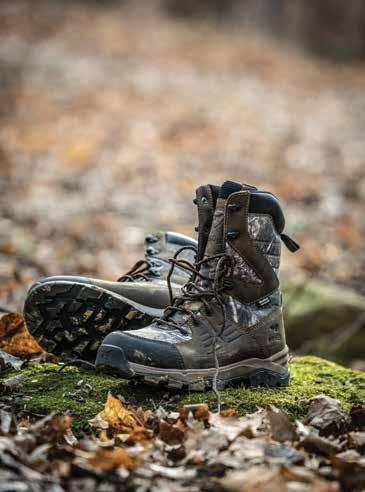
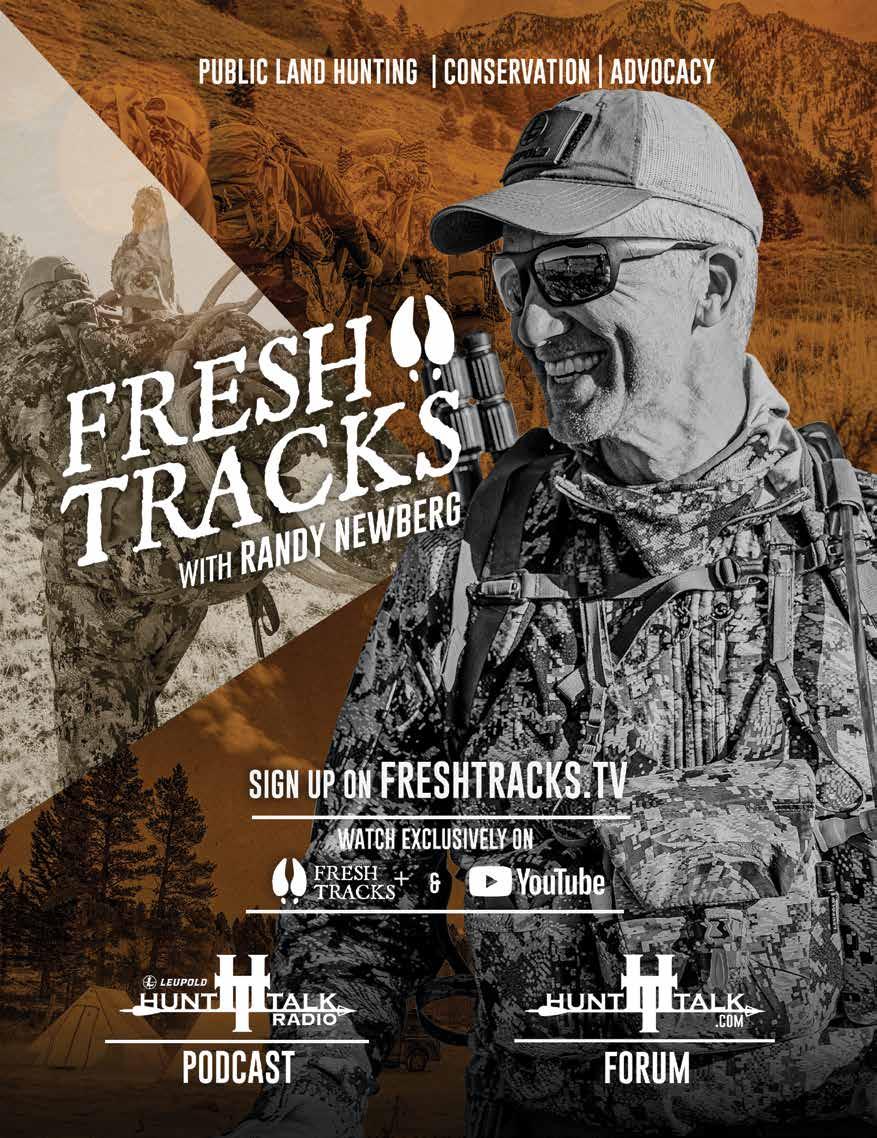
Tuckahoe Creek is a small tributary that deposits its muddy water into the Choptank River. Water that meanders through the bean and corn rows of local farms finds its way to the Choptank and then ultimately Chesapeake Bay. Most passing through the sleepy little towns that barely receive a cartographer’s mention would undoubtedly pass this particular crossing without thought or intention. It’s not a destination like other bodies of water; there are no falls to harvest camera clicks or rapids to catch laughter and rushing hearts. No, the Tuckahoe sits quietly – dutifully carrying water and sediment downstream for deposit.
Not long ago, I passed over a portion of Tuckahoe Creek. It had been 30 years since I had been in this spot, but I looked for it with the same excited anticipation I used to – as if I was sitting in my father’s truck, awaiting the dirt pull-off by the bridge. It was hard to find as the bridge spanning the creek was the only navigational aid. I pulled over and remembered my way down the incline to the river’s edge. The growth of the vegetation confirmed that it was no longer a favorite spring perch spot among the locals – probably due to the draw of the new digital ways in which to spend youth. I was saddened not to catch a father and son tossing their bobbers out into the middle of the creek. One likes to pretend that as time passes some things just don’t change.
often were; well-intentioned fishing trips often lead to rambling escapades.
The Choptank Tribe inhabited much of this area. In fact, 400 years ago, an area like our little perch spot would certainly have been a favorite of local Native Americans; this wide, deep part of the creek collected perch as they stopped to lay eggs. In addition to harvesting the abundance contained in these waters, the Choptanks hunted deer and other game. The 400-year-old artifacts of their missed shots were deposited all over Tuckahoe Creek and the surrounding area. I was amazed at how the remnants of those hunting trips could still find their way into our modern hands. Arrowheads were spotted on almost every trip to this fishing spot.
My father has an uncanny ability to spot the irregular shape of an Native artifact. It’s as if he looks through a different lens than the rest of us. He explains it as, “You can just tell that something doesn’t belong; it’s like looking at a bottle cap laid in with a bunch of rocks.” What appeared as a mediocre skipping stone to a child, indeed could be an arrowhead. Seemingly insignificant riverbanks and newly plowed fields were grand opportunities.
“There must be one in this area,” he would opine, certainly already spotting one, but giving me the chance to find it. “If he would have taken a shot from over in that direction, surely it would have landed in this area,” drawing a circle with a stick to constrict my area of search and increase my chances. “No, see that one doesn’t have the manmade edges of an arrowhead.” My search would continue until ultimately, after sifting through a dozen or so stones, I would stumble upon it, proud of my find and oblivious to the actual method by which it was discovered.
This was my classroom, and my father and sometimes uncles were my learned professors, carefully, maybe unknowingly filling my toolbox with all that I needed to live a life worth living.
The walk from the end of the steep slope to where my father would sit patiently as I did not, casting and recasting, was just 20 or so feet. I walked over and crouched down. I found a few good skipping candidates and proceeded to bounce them across the water; I stopped so as not to scare the fish.
I imagined sending out that first cast with the childish confidence we all have that our bobbers will instantly disappear from the surface. As with many trips that teach us that fishing really isn’t about the act of catching fish, the ones spent on this little stretch of the Tuckahoe often ended with an empty frying pan but not an empty soul. This was my classroom, and my father and sometimes uncles were my learned professors, carefully, maybe unknowingly filling my toolbox with all that I needed to live a life worth living.
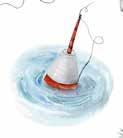
Fishing trips were never just that. The ends of our rods sticking out from the back of the tailgate was the only element required to announce that we were “going fishing.” Most times casts would be thrown, but the fact of the matter was that my father could be just as impatient and curious as I was. And that is how our fishing trips
The escapades have transcended generations; when we visit him on his farm, my father still leads the expeditions with my children. Today as we walked down the newly turned fields, I lagged the group, enjoying the site of my children’s unbridled joy. My dad crouched down and pointed his arm toward a pond, undoubtedly ascertaining the direction of an ancient arrow. As the children put their hands up as visors and peered in the direction of the shot, I noticed a few stones tumbling out of my father’s left hand. Standing up and drawing a circle with a stick, I heard him confirm his suspicions once again, “They surely would’ve landed in this area.” The sifting ensued as my father turned my direction and laughed, catching my expression as I decoded the mystery of my own youth.
BHA member A.R. Thompson grew up hunting, crabbing and fishing around the Chesapeake Bay. He currently resides in Chester County, Pennsylvania, with his wife and three children.
Editor’s Note: A previous version of this article appeared in Attractions Magazine (2022).


WINDPROOF WHERE YOU NEED IT, BREATHABILITY WHERE YOU DON’T SO YOU NEVER TAKE IT OFF

Built for high-exertion backcountry pursuits, the Mountain Evo Jacket uses strategically body-mapped fabrics to provide windproof protection where you need it most while also allowing exceptional breathability and stretch, so you stay dry and comfortable throughout your hunts. WINDSTOPPER® by Gore-Tex Labs product technology stops heat-sapping gusts in their tracks, while 4-way stretch panels dump heat and allow unrestricted movement. The result is a jacket you can put on in the morning and not have to think about for the rest of the day.

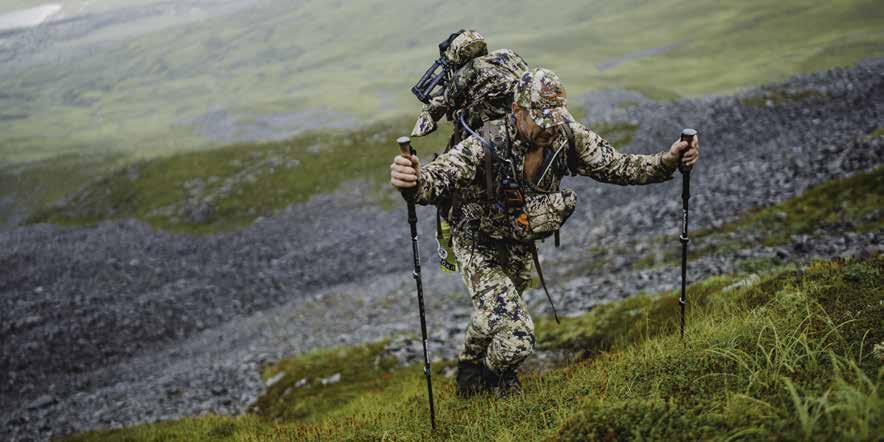
In 2021, my son Pete Kvale and I harvested a banded male blue wing teal at Thief Lake Wildlife Management Area in northwestern Minnesota.
The condition of the band on this beautiful male teal was very deteriorated and thin with only two of the nine numbers clearly visible. After acid etching the numbers, 1095 87238 revealed themselves. I reported the band to the U.S. Fish and Wildlife Service bird banding office in Laurel, Maryland, and received an email documenting the age of this teal to be at least 10 years old. Quite a feat of longevity for such a long range, small traveler.
The bird was banded on Big Grass Marsh in Manitoba. Big Grass Marsh is the site of the first Ducks Unlimited project ever undertaken by DU Canada, in 1938, to partially restore a wetland area of 100,000 acres of land, drained in the late 1880s and early 1900s for agriculture purposes, which had ultimately failed miserably. DU and the province of Manitoba have restored portions of this area, which is now permanently protected from further agricultural development. Big Grass Marsh is designated a Canadian “Important Bird Area” and banding site and is a remarkable example of wildlife habitat restoration on public lands and waters.
The teal represents my most memorable “trophy” from over 60
years of waterfowling. Trophy is a funny, often misrepresented, word in the pursuit of hunting that often depicts machismo, bragging and other less desirable human traits. But, really, it’s much more than that. Trophies can be anything, be it a leg band, a feather, a piece of sagebrush or a head on the wall. And they represent the experiences and stories that we love to share and cherish for lifetimes and pass on to future generations. Those stories are the real trophies and don’t need a leg band or a head on the wall to commemorate – maybe a jigger of good bourbon or scotch, or just a campfire and friends.
The band on this teal is a treasured trophy to me not because it’s another band or “jewelry” on a call lanyard but because of the incredible conservation story it tells. A teal that lives to 10-plus years is obviously the result of good habitat and public lands and waters management and protection. It reminds me I have been privileged to be present for a good portion of the North American conservation story and fortunate to have contributed in some small way to the legacy of wetland and wildlife conservation and the protection of our public lands and waters.

On a community level, it reminds me of the part you and I and the little blue wing teal play in those conservation success stories. That little leg band also speaks to those yet to come who will continue those incredible stories and tell tales of their own “trophies” and experiences around the conservation campfires of the future.
Greg “Cattail” Kvale is a BHA life member from Minnesota who spends most of his time in the outdoors, volunteering for conservation or cooking in the kitchen and, when absolutely necessary, doing yard work. He and his son Pete are two-time BHA Wild Game Cookoff champions.
The Campfire Circle is a group of dedicated advocates, like you, who choose to donate $1,000 or more per year to ensure that BHA’s campaigns, advocacy and on the ground efforts on behalf of our wild public lands, waters and wildlife are sustained. Support from the Campfire Circle (formerly known as Legacy Partners) is crucial to the mission of BHA.
Our shared lands, our responsibility. We are working to diversify our funding sources to ensure that BHA will always be working on behalf of our wild public lands, waters and wildlife – for generations to come – by establishing a $1 million endowment. This investment will grow and become a perpetual funding stream that exists to support the future needs of our organization, regardless of any unpredictable challenges beyond our influence. Give today to form the root structure that will sustain BHA for many years to come.
Including Backcountry Hunters & Anglers in your plans for the future will create a long-lasting impact for our wild public lands, waters and wildlife. Your commitment to BHA will allow the next generation of conservation leaders to continue our work as part of your legacy. Including BHA in your will, trust, retirement account or life insurance policy is one of the easiest and quickest ways to support the future.
You can choose to make one donation at a time or become a sustaining donor and make monthly donations. All donations are fully tax-deductible and go toward securing the future of hunting and angling – ensuring that you have access to public lands and waters and healthy fish and wildlife habitat when you get there.
Support BHA every time you search online by using search engine Bing’s Give Mode.
Put your vehicle towards public lands and waters through Vehicles for Charity.


Backcountry Hunters & Anglers works for the future of hunting and angling on wild, healthy lands and waters. The education of our youth and the opportunity for all to experience the outdoors are at the core of BHA. The Aidan Long/Outdoors For All Scholarship is open to anyone aged 21 and under to mitigate the expense of outdoor recreation and conservation education and to expand experiences and opportunities for people with disabilities via the purchase or temporary acquisition of adaptive recreation equipment. Please consider making a donation to the Aidan Long/Outdoors for All scholarship fund to help increase equal-opportunity access to the outdoors for all. Learn more at backcountryhunters.org/outdoors_for_all
(May 27, 1951 – February 14, 2023)
It is with great sadness that I write this tribute about a true friend of mine and a true friend of the wild.
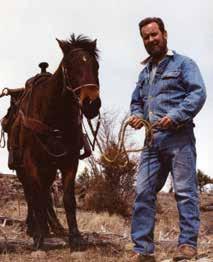
Doug Martin was employed as a senior habitat protection biologist with the British Columbia Ministry of Environment for over 40 years before his retirement in 2017. He had a long record of passionate advocacy for the protection and preservation of wildlife habitat in the Kootenays and, in 2005, he was presented with the Ecosystem Officer of the Year award.
Doug was a founding member of the British Columbia chapter of BHA and was the persistent voice in my ear to bring this much needed organization to BC to stand up for our wild crown lands, waters and wildlife.
One of Doug’s responsibilities as a habitat protection biologist for the Kootenay Region was access management planning. This was always a contentious
land management issue and a real challenge when attempting to protect wildlife habitat and quality hunting and angling experiences through the establishment of motor vehicle closed areas. Fortunately for wildlife in this region of BC, Doug and the fish and wildlife branch staff at the time were persistent, and to this day the legacy of Access Management Areas remains.
Doug realized he needed a new ally in the habitat and protection business, and he recognized this in BHA.
Doug became a habitat protection biologist not for a job, but because he cared. He joined BCBHA not because he hunted or fished, but because he cared. Doug, we will miss your incredible sense of humor, your sage wisdom and your guidance. Thank you for your contribution to the legacy of wild places and wildlife in British Columbia.
member

Please contact admin@backcountryhunters.org or visit backcountryhunters.org/donate for more ways to support BHA.
“To catch and release? Or catch and fillet?” If Hamlet was an angler, he would have surely asked the question.
So, which is nobler?
If you’ve read the Beyond Fair Chase column before, you know it’s not a simple question, and it won’t be accompanied by simple answers. It will cause contemplation, require critical thinking and challenge personal beliefs.
Hunting and angling ethics are underpinned by a few quintessential questions. These questions help distinguish ethical issues from those never-ending, “faux ethical” issues, like debating choices between fly or spinning gear, firearms or archery equipment, Brittanys or black Labs, etc. While these are entertaining conversations, they aren’t truly about ethics. The QQs:
• Is it legal? (This is the lowest bar for an ethical hunter or angler to clear.)
• Does the animal have a reasonable chance of escape? Is it “fair chase?”
• How can the hunter/angler minimize unnecessary suffering?
• Does the action benefit or harm the wildlife resource, other hunters and anglers or the larger human family?
Using these QQs, catch and release and catch and fillet can both be noble – or not! First, let’s define each. Catch and release is fishing without the intent to keep any fish caught. Catch and fillet (selective harvest) is fishing with the intent of keeping some fish. It’s important to understand that people who catch and keep fish also release fish. They may release undersized or oversized fish, non-target species, etc. It’s all about intent.
Selective-harvest and catch-and-release fishing both kill fish – intentionally or unintentionally, visibly or out-of-sight of the angler. Mortality associated with catch and release is always unintentional, but it is mortality nonetheless. If a fish dies after being returned to the water by an angler fishing for food, it is a byproduct of harvest, of “making meat.” Fishing for food brings fish mortality to the surface. But if a fish dies after being returned to the water by a catchand-release angler, it is a byproduct of personal indulgence and may remain unrealized by the angler.
Is it wrong to catch and release fish for pleasure? Is fish mortality more or less acceptable based on if the angler is aware of and intentional about it? How can we choose to fish nobly?
For some, catch-and-release fishing is paramount. For others, it is tantamount to animal cruelty. The issue of cruelty often centers around the questions of if and how fish feel pain. We’ll avoid the confusion of animal rights arguments and consider animal cruelty
as a moral law: All men and women, everywhere, understand the responsibility to treat animals compassionately. So let’s focus on ethics and the third and fourth QQs, instead.
Depending on the species and other factors, mortality from catch-and-release fishing is 5-30 percent. From a fish population perspective, this is better than 50-100 percent, especially recognizing that when selective-harvest fishing, each fish might be caught only once. When catch-and-release fishing, a single fish might be caught multiple times. The iconic angler Lee Wulff once said, “Game fish are too valuable to be caught only once.”
Catching fish multiple times increases our responsibility. If we concede that fish are stressed from the time they are hooked until the time they are released, and potentially after – no matter our intent or fishing method – reducing stress, minimizing unintentional mortality and providing benefit to the fishery are our individual responsibilities. Paradoxically, anglers who selectively harvest two fish and are on the water for an hour may have a smaller impact on a stream than anglers who spend the entire day catching and releasing.
In a crowded world, catch-and-release fishing is one way of managing fish populations. Under some conditions, catch and release can help keep fish populations high, allowing them to reproduce. After the first Earth Day, catch-and-release fishing flourished. It helped conserve and restore important native fish populations. The benefits of catch-and-release fishing are magnified when restoring native fish populations and/or where there is heavy fishing pressure. In some instances, it may be the only viable option for allowing fishing opportunities over threatened fish populations.
In other instances, selective harvest is a better tool. Harvesting non-native fish (some of which are popular game fish) is often crucial for native fish restoration. Angler reluctance to harvest non-native fish, whether they are smallmouth bass, snakeheads or brook, brown or rainbow trout often runs counter to conservation goals. If the habitat is in good shape, selective harvest may help achieve conservation goals. It has the added benefit of providing organic, free-swimming protein. Eating wild caught fish, from healthy habitats, is at least as ethical as buying fish and teaches us where our food comes from. Keeping more fish than you can eat, however, is waste. Biologically, carrying capacity eclipses all. Let’s visualize a river with a carrying capacity of 1,000 pounds of trout per mile. The river, lake or pond and the fish don’t care if there are a lot of small fish, a few big fish, or fish of all sizes. In most cases, harvesting some smaller fish, will help increase the average size of fish.
So, which is nobler? It’s possible to fish ethically whether you practice selective harvest or catch and release. Both methods require knowledge of the water and fish species. They require you to improve your abilities and have the right gear to land and handle fish in a way that minimizes stress.
Ultimately, ethical angling is not about judging each other. Rather, it’s about staying focused on real problems like habitat, aquatic invasive species, water quality, etc. It’s about the opportunity for you to understand how you and your actions affect the environment.
Patt Dorsey is a life member of BHA and an Orion board member. She loves to fish and practices catch and release and eats wild fish occasionally.




 BY JEFF BENDA
BY JEFF BENDA
I love Reuben sandwiches. One of my favorite recipes I ever developed is a Canada goose pastrami Reuben. But I also spend a couple of weeks in the Tampa Bay area of Florida each year where a grouper Reuben sandwich has become a staple at many seafood restaurants. Some versions I’ve found use broiled fish, but I prefer blackened, which helps kick it up a notch.
I borrowed the idea for this sandwich and brought it home to North Dakota where walleye runs supreme. Walleye is delicate, flavorful and complimented extremely well by the classic Reuben ingredients: marble rye, Swiss cheese, sauerkraut, pickled red onion and Thousand Island dressing. The key to this recipe is allowing the main ingredient – the walleye – to stand out. The amount of dressing isn’t excessive. The cheese isn’t heavy like a McDonald’s fish sandwich. The bread is buttered, toasted and good to the last bite.
• 2 6-ounce walleye fillets
• 3 tbsp butter, divided
• 1 tbsp olive oil
• 2 tsp Cajun blackened seasoning
• 4 slices marble rye bread
• 4 tsp Thousand Island dressing
• 4 slices Swiss cheese
• 1/2 cup sauerkraut
• 1/2 cup pickled red onion
Instructions
1. Pat fish dry with paper towels.
2. Heat a large, nonstick pan over medium-high heat for 3 minutes.
3. Melt 2 tbsp of the butter in a microwave. Dip the fish fillets in the melted butter, then dredge in the blackened seasoning. Shake off any excess.
4. Add fillets to pan and cook 2 minutes on each side.
5. Meanwhile, spread remaining butter evenly on both sides of each piece of marble rye.
6. Spread 1 tsp of Thousand Island dressing on one side of each slice of bread, then layer with a piece of Swiss cheese, 2 tbsp of sauerkraut, and 2 tbsp of pickled red onions. Then add the cooked walleye fillet.
7. Grill sandwiches about 2 minutes per side until they’re golden brown and the cheese is melted. Serve immediately.
BHA member Jeff Benda is the founder of Wild Game & Fish Media, where he is a full-time wild game and fish recipe developer living in Fargo, North Dakota. You can follow his hunting, fishing and cooking adventures on Instagram @wildgameandfish or on his website wildgameandfish.com

The lengthening days of spring hadn’t eased the schedule. As the clock ticked toward the deadline to send this summer issue of Backcountry Journal to press, the End of the Line column lay vacant.
My mind had spent most of the season far from my own fishing and hunting opportunities – occupied by building an oversized and overpriced chicken coop, preparing this issue, wrangling a toddler and fighting off the multiple illnesses she brought home from preschool.
Montana’s April weather this year was so crummy I really didn’t feel I was missing much – my north-facing yard didn’t lose snow until the second week of the month. But a warm start to May and rapidly greening hillsides turned my attention to the mountains –which in turn provided motivation to complete the coop.
It’s easy for my brain to kick into overdrive and stay that way when I’m not getting time on the water or in the woods. You know those little toy cars that you push in reverse across the floor to charge the engine? My mind felt like one of those going “click, click, click” at the max wind-up – waiting to be unleashed across the living room floor. I’ve found there’s nothing like sitting behind a pair of binoculars or a spotting scope to kickstart the unwinding.
With that in mind, I took advantage of a little mother-in-law help with the toddler to slip away for an evening. The whole charade was guised as a bear hunt – it’s been one of those springs where you feel like you need to provide yourself a good excuse to not be working on one of the many things you should be working on. Otherwise, you’ll just feel guilty the whole time. A “bear hunt” sounded like a better excuse than simply sitting behind a spotting scope for no other reason than “looking at things.” Besides, I had a few areas I wanted to “bear hunt,” which really meant I wanted to explore them for future elk hunting endeavors. The bear hunting part interests me, too– but it’s hard to call it a hunt when you are going in with zero planning or scouting and are not likely to have time to go again.
Anticipation built the entire week prior, until the evening before, when a strange haze appeared, and the sun turned that apocalyptic red that’s become all too common in recent years in the West. Being that it was only May, my wife and I were doubtful it could
be wildfire smoke – until we hit up Google, and it was: Alberta and British Columbia were on fire.
My glassing visibility – and hunting enthusiasm – were disappearing by the minute, but given the desire just to be in the mountains, what else could I do but go anyway?

With that in mind, I slipped away with my friend Corey for an afternoon and evening behind the glass. I’d hunted the spot I had in mind several times a few falls back, and in addition to seeing a fair number of deer and some good elk sign, it seemed like an ideal spot for spring bear. That year, I never saw another person, but last fall Corey and I tried to hunt it and had been beaten to the spot by another truck well before daylight, so we were itching to get in there ourselves this time.
Unfortunately, in a repeat performance, we were greeted by a parked truck when we got there – which completely surprised us since it was midweek, and I didn’t think spring bear hunting crowds compared to those of fall. I guess the spot isn’t as overlooked as I’d originally thought. The plates were from way out of state –Massachusetts – and since the rig had a BHA sticker and it seemed a long way to travel, we didn’t want to spoil his time, so we headed in another direction.
Exploring new ground is half the fun for me anyway, so we hit plan B, which looked great on onX anyhow. All was shaping up and the country had bear written all over it. But then we were disappointed to spot orange coming our way across the hill we were glassing. It was really hot out – like a record hot 85. And when the other hunter plopped down in the middle of our spotting scopes and took his shirt off to sunbathe, we started to lose enthusiasm.
Relocating a short distance over the ridge and glassing the next drainage, which looked even more beary, helped, but as the hours ticked by it seemed unlikely anything would show. It’d be easy to find it all as time wasted, but as I drove back home I couldn’t help but feel refreshed and was already looking forward to the next evening spent behind the glass – bears or not.
-Zack Williams, editor
